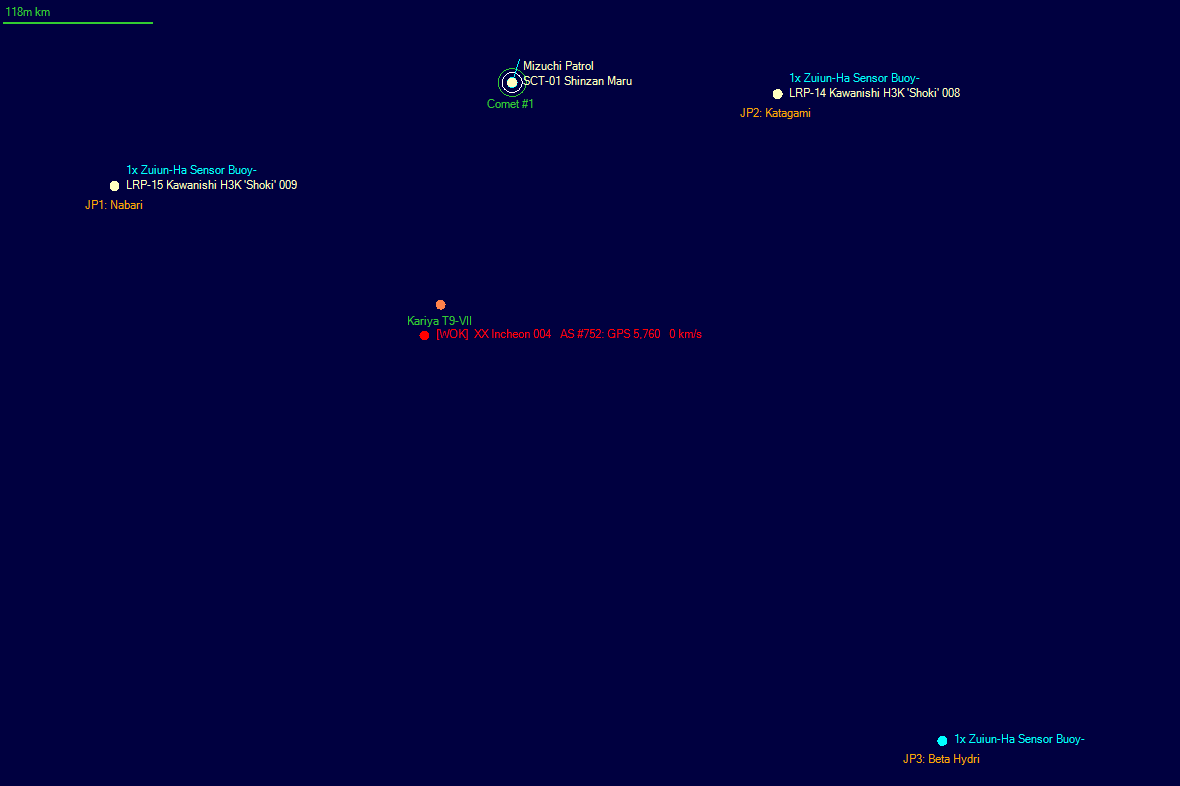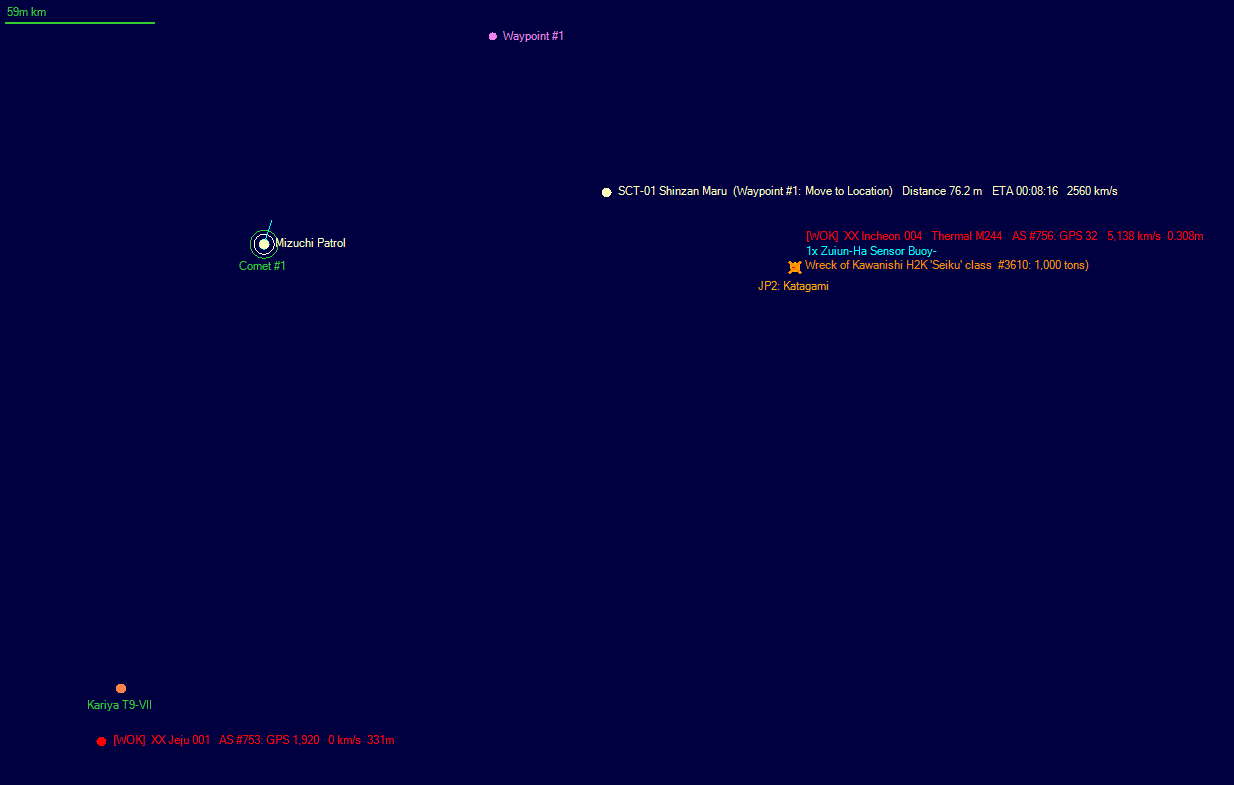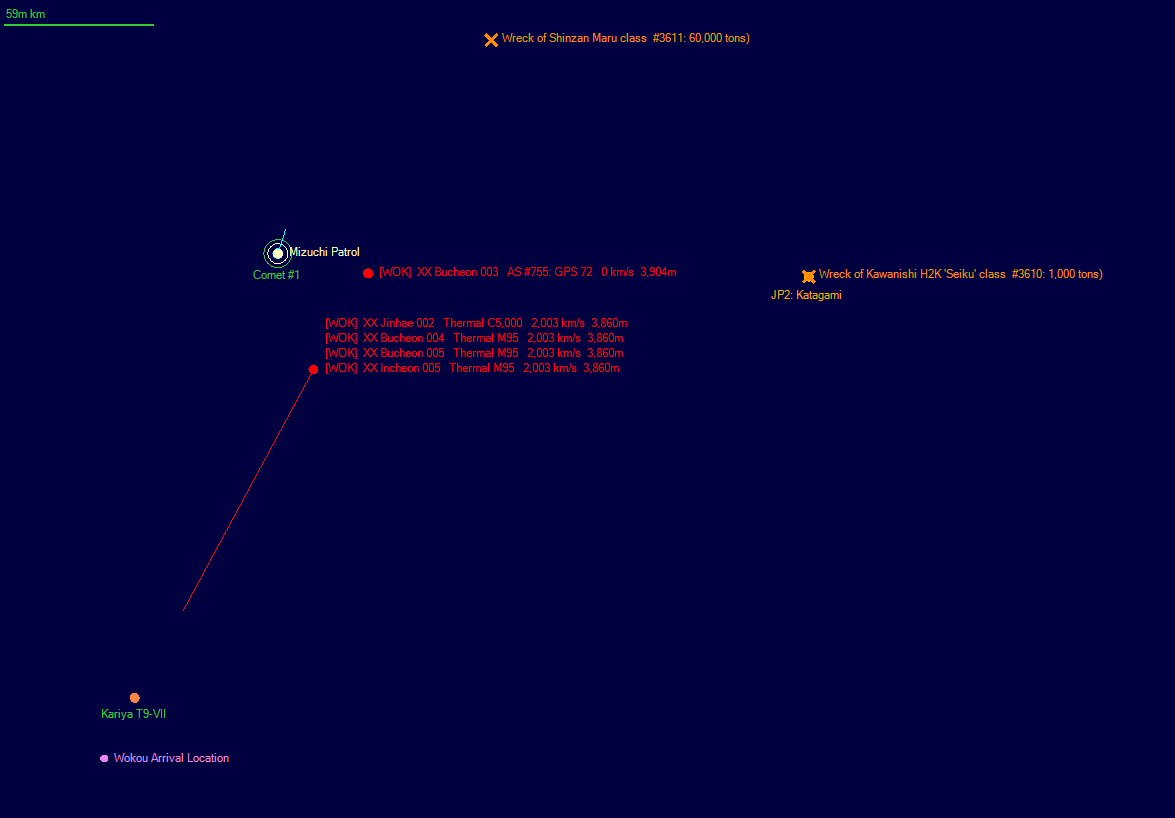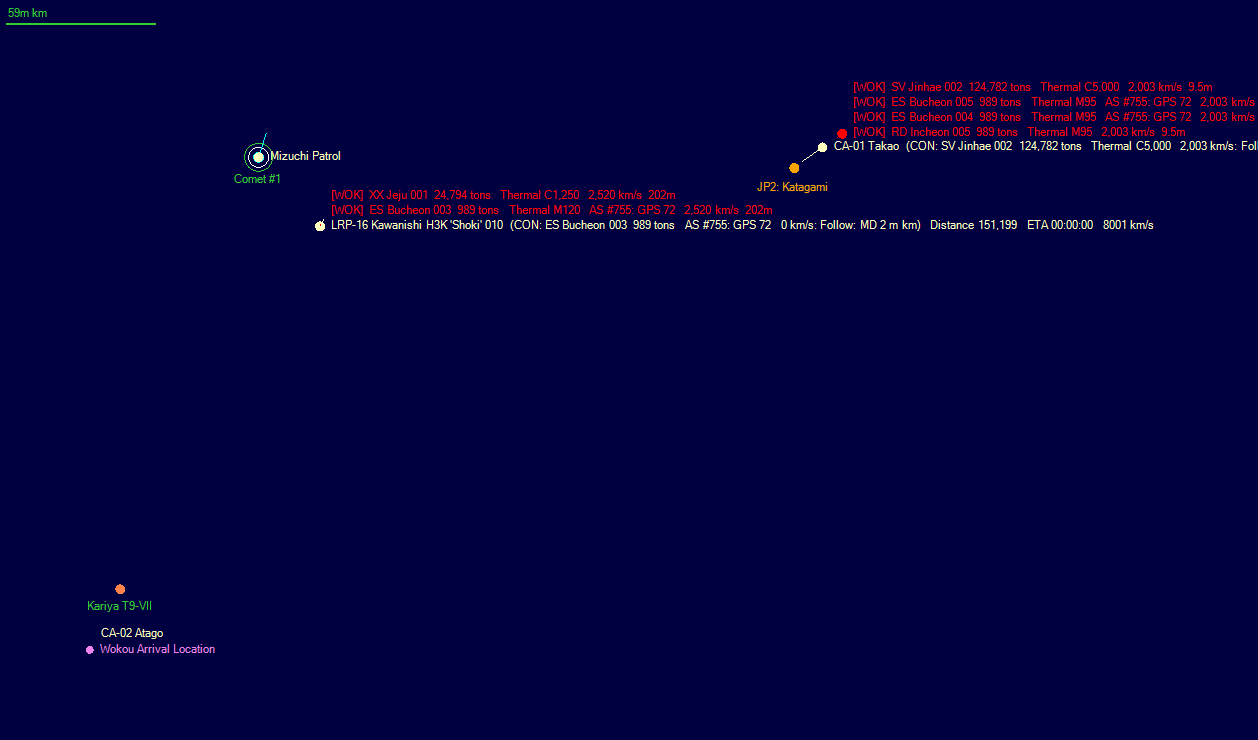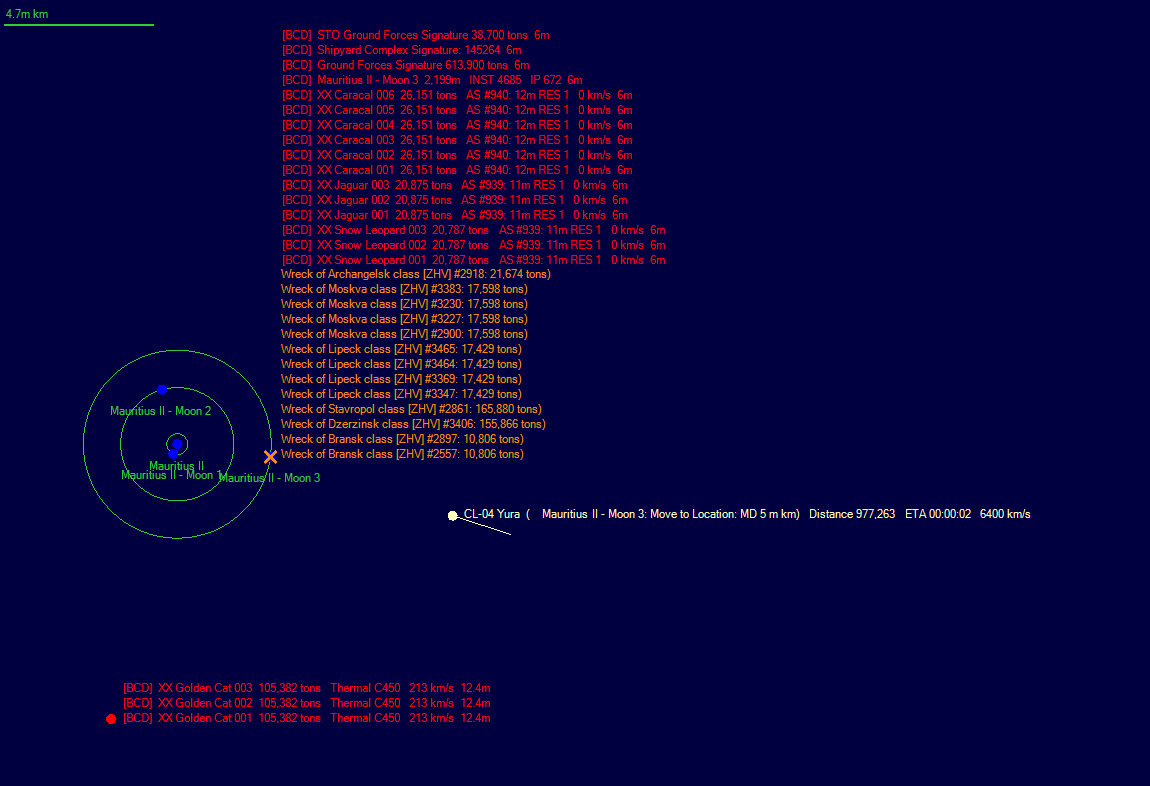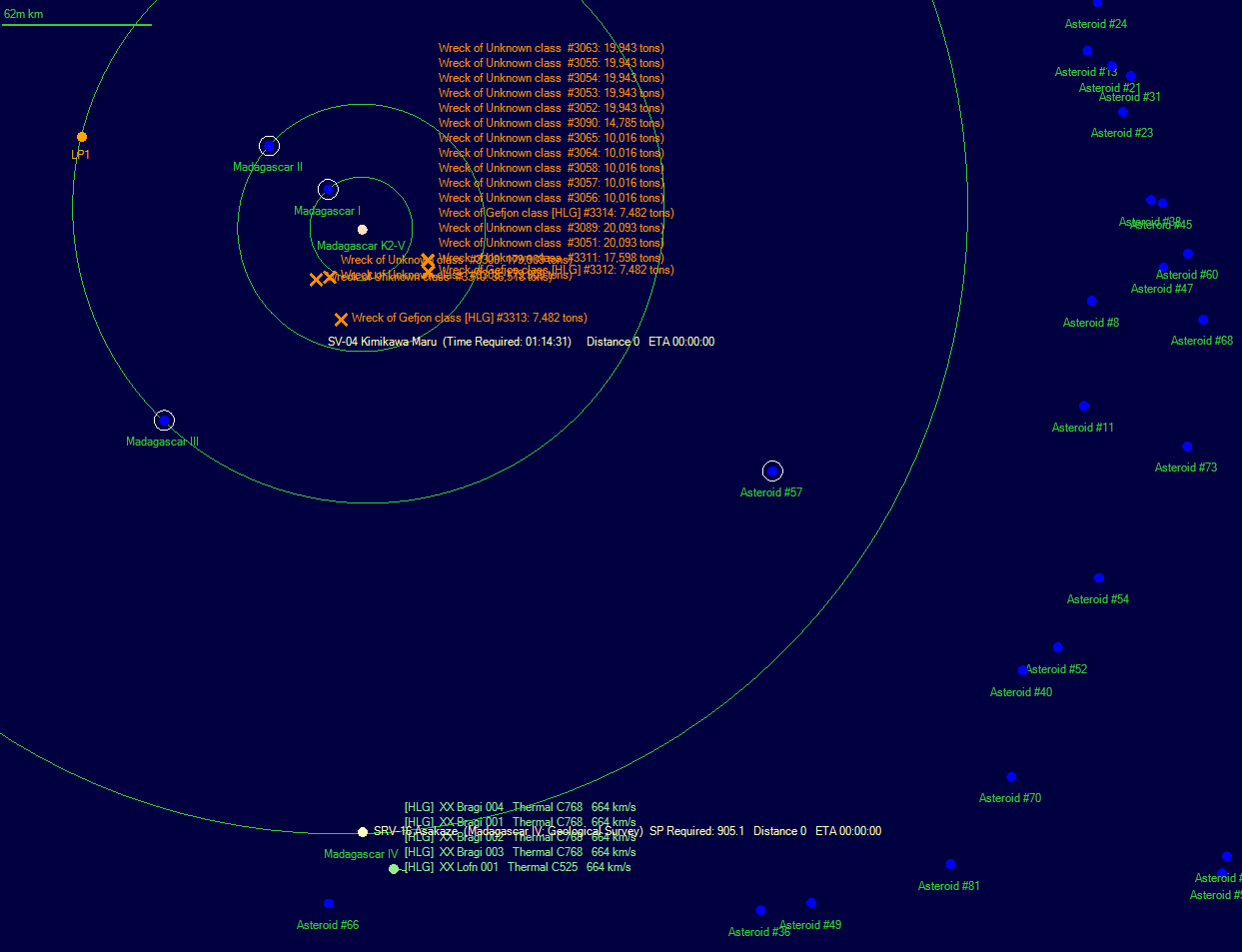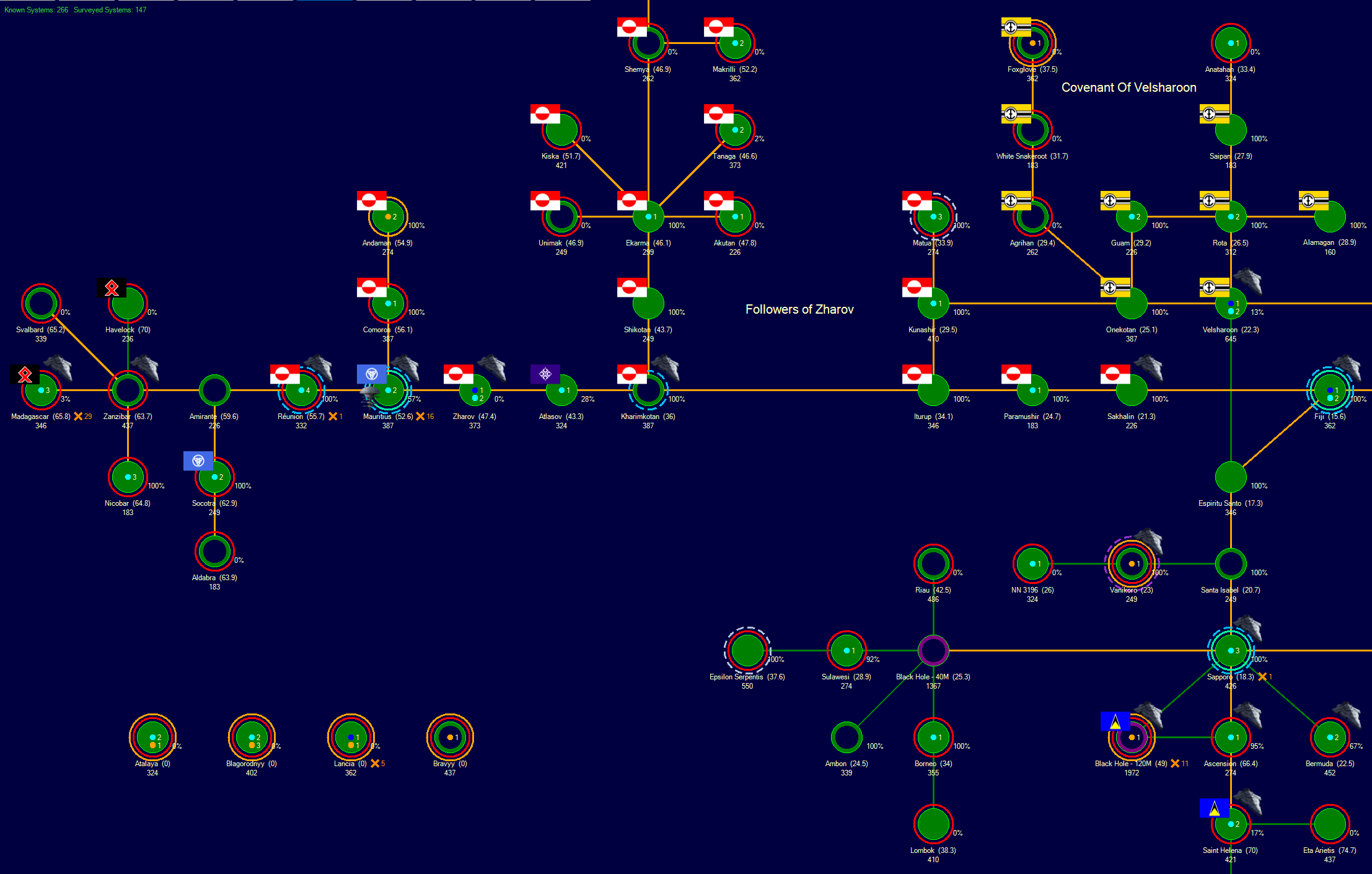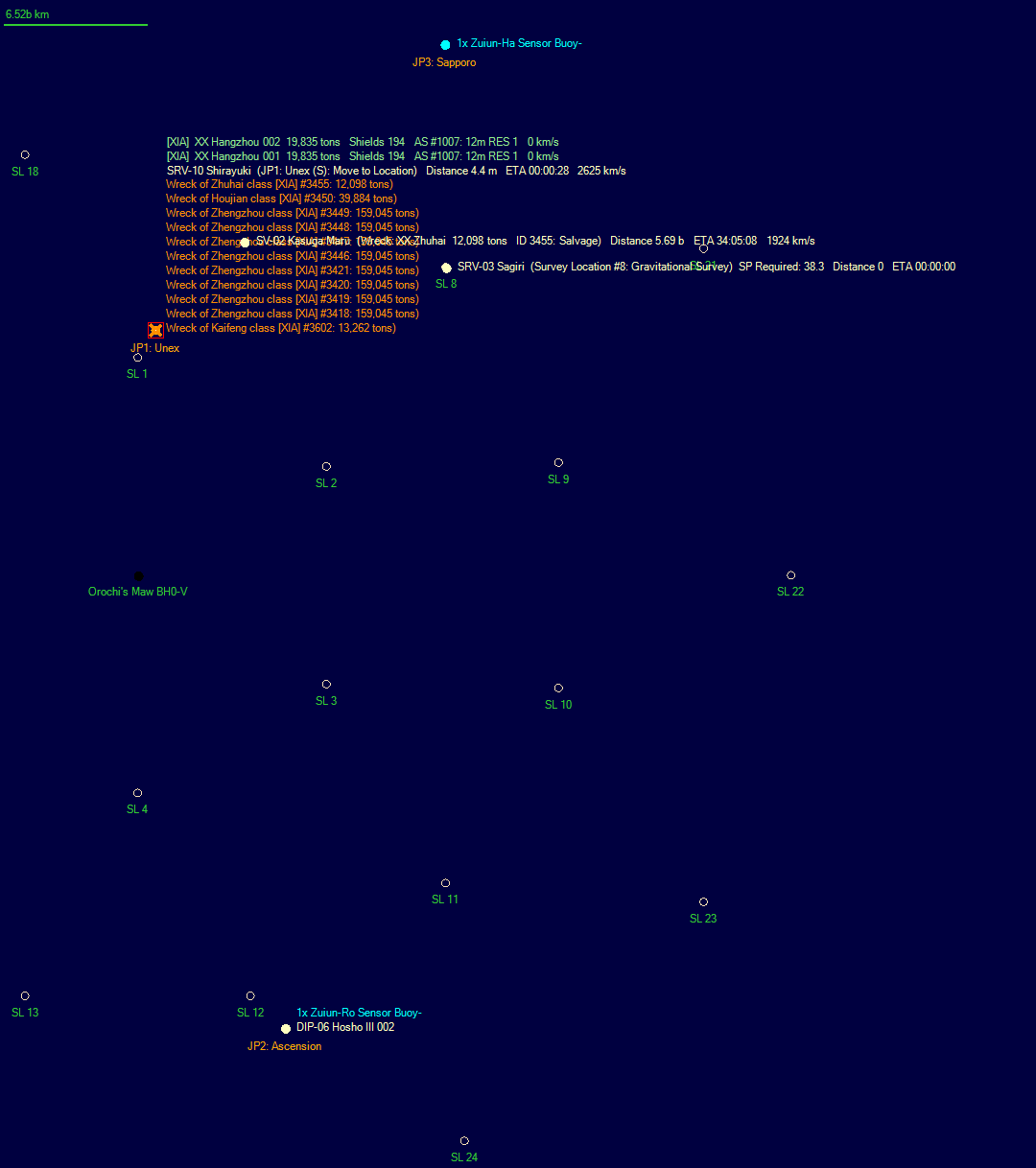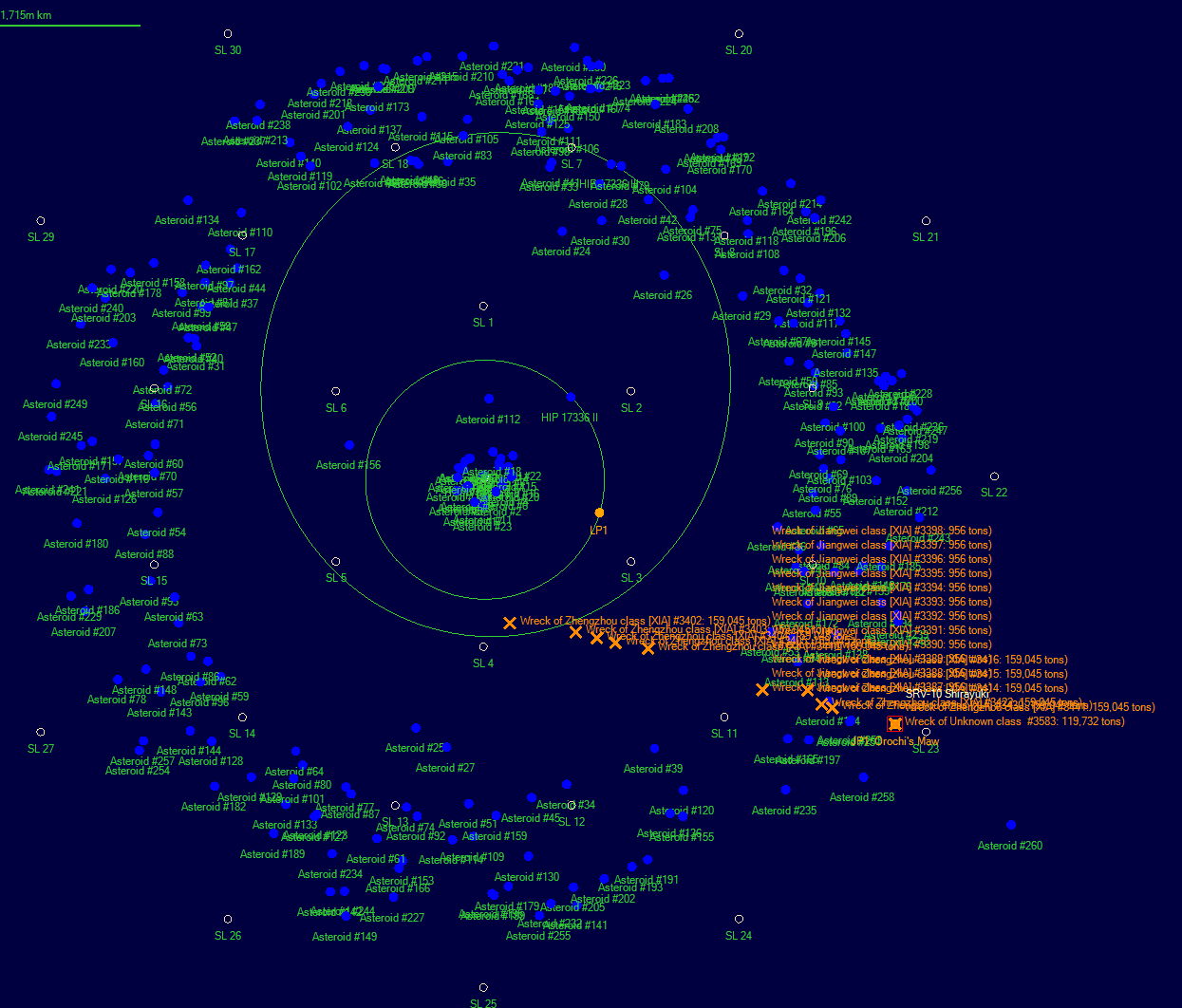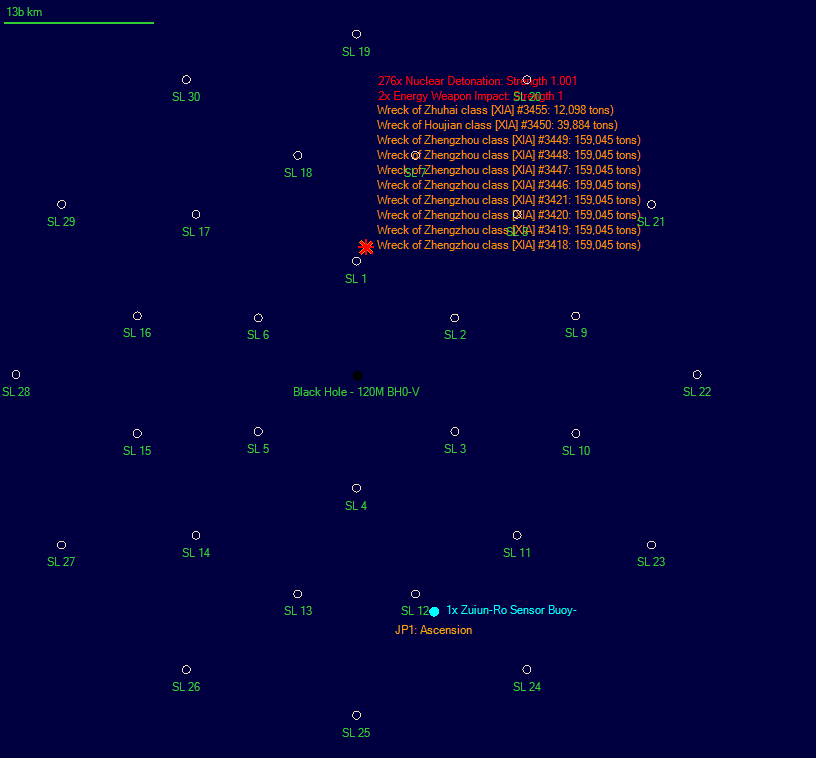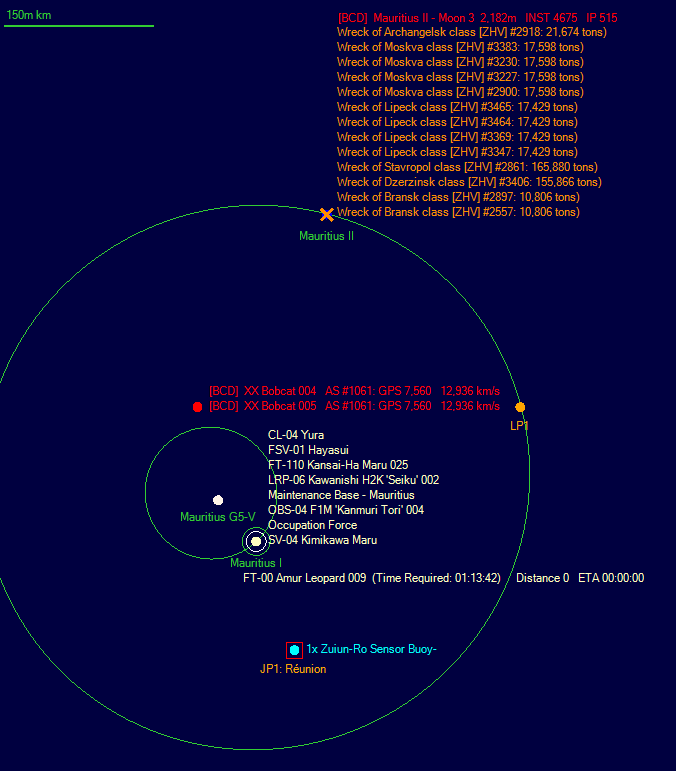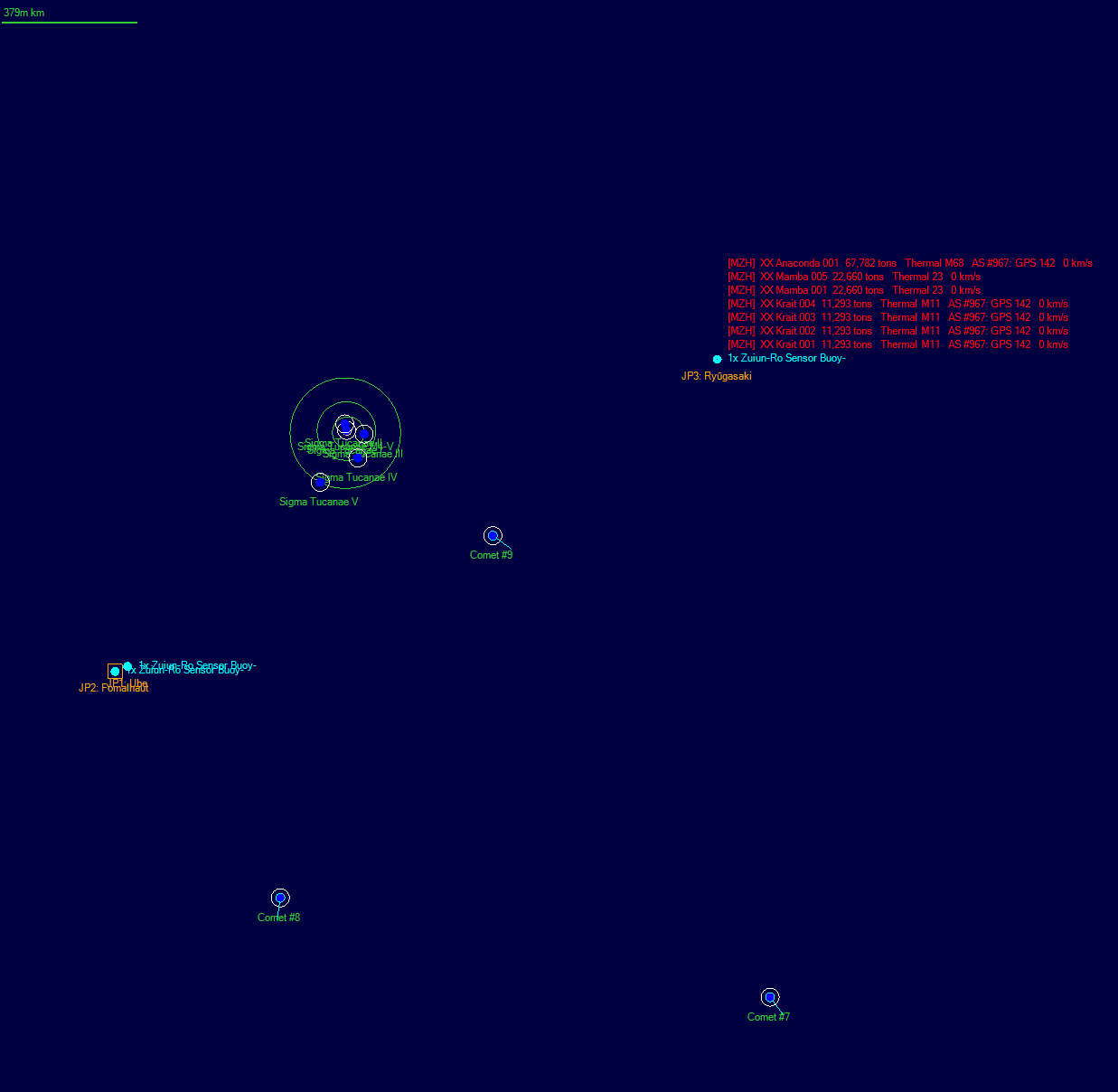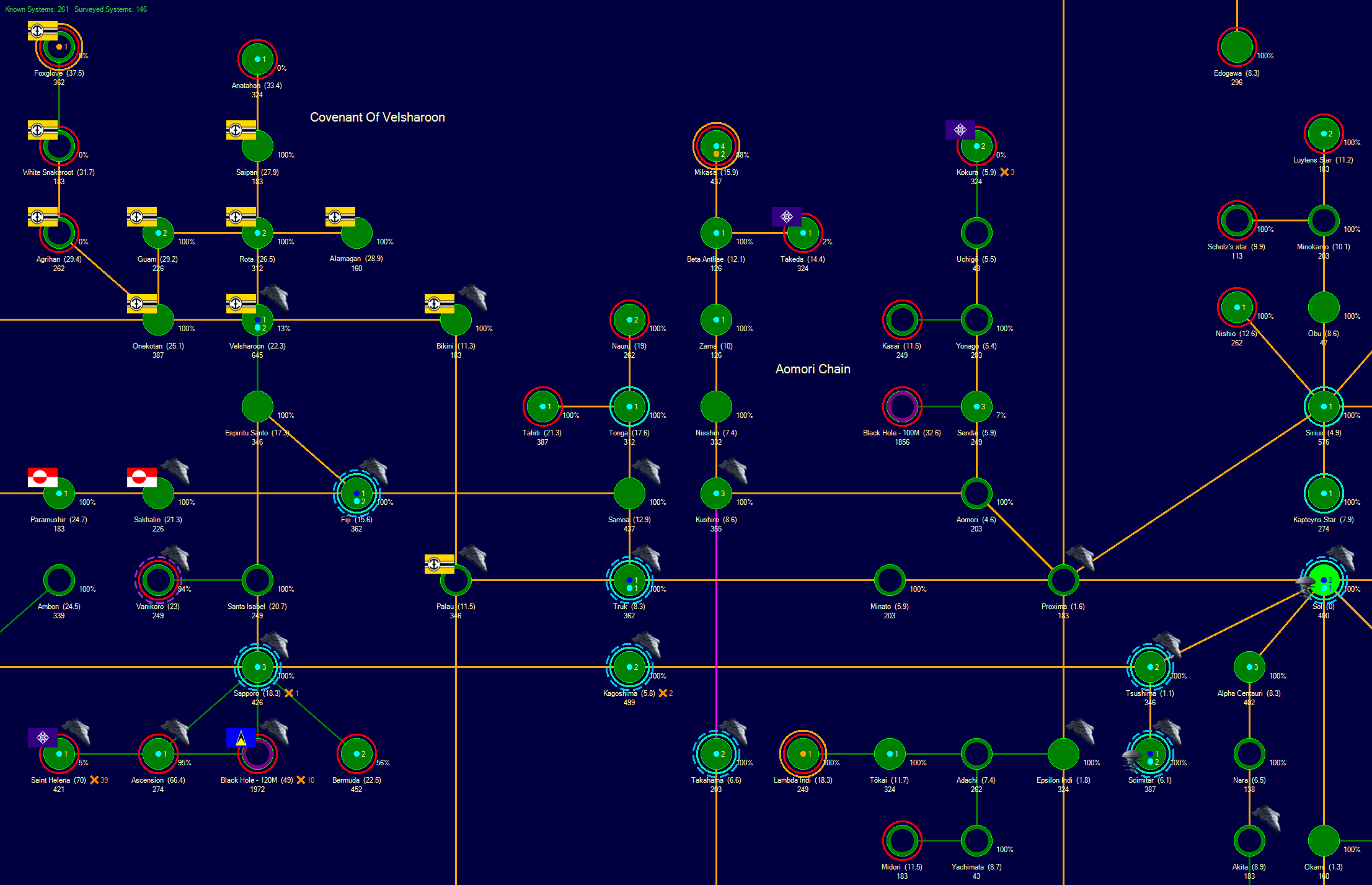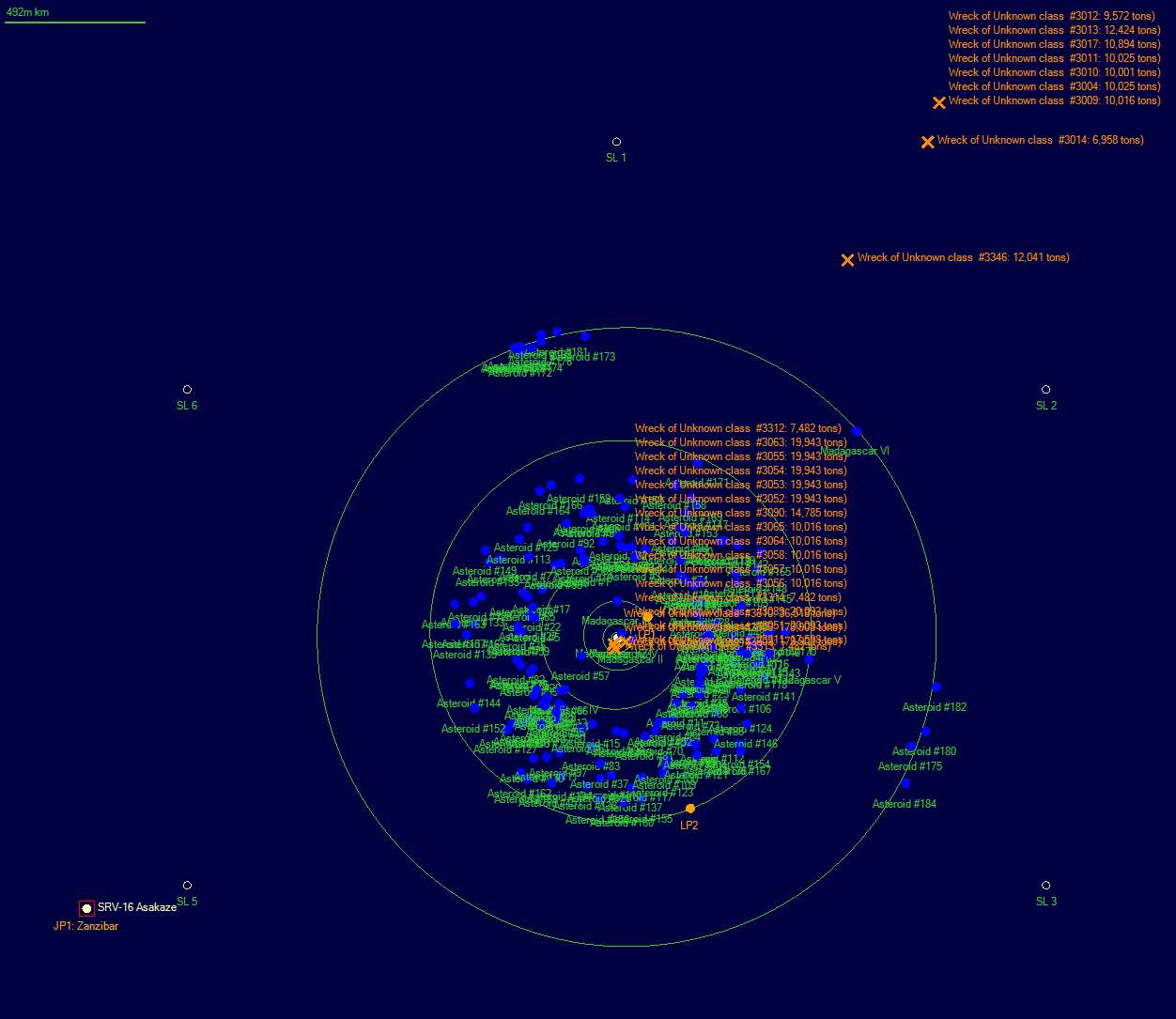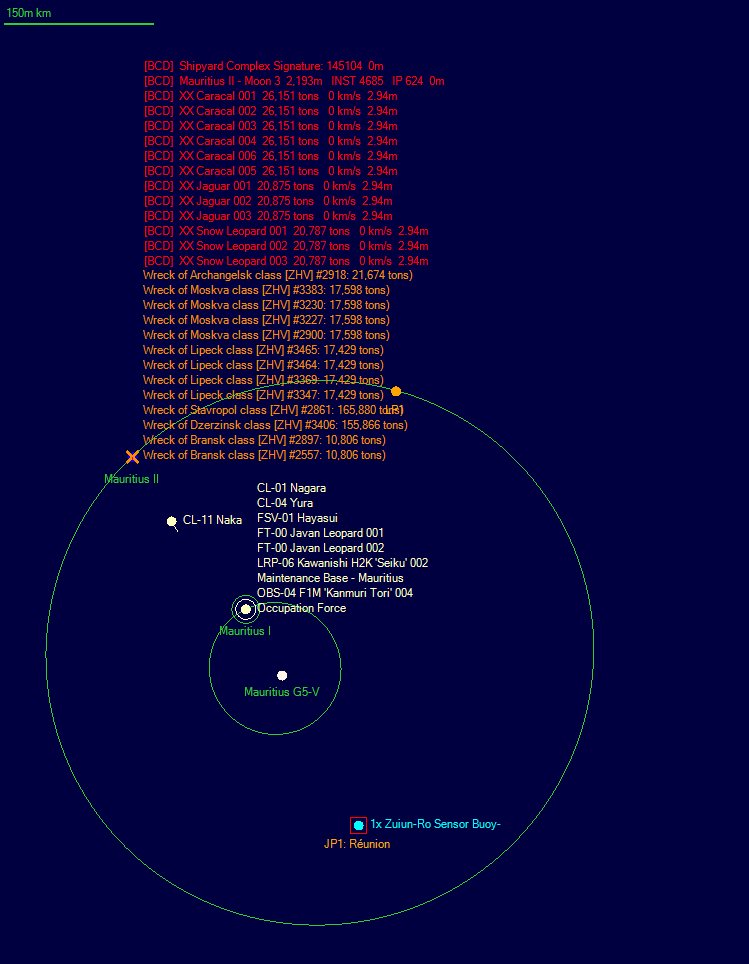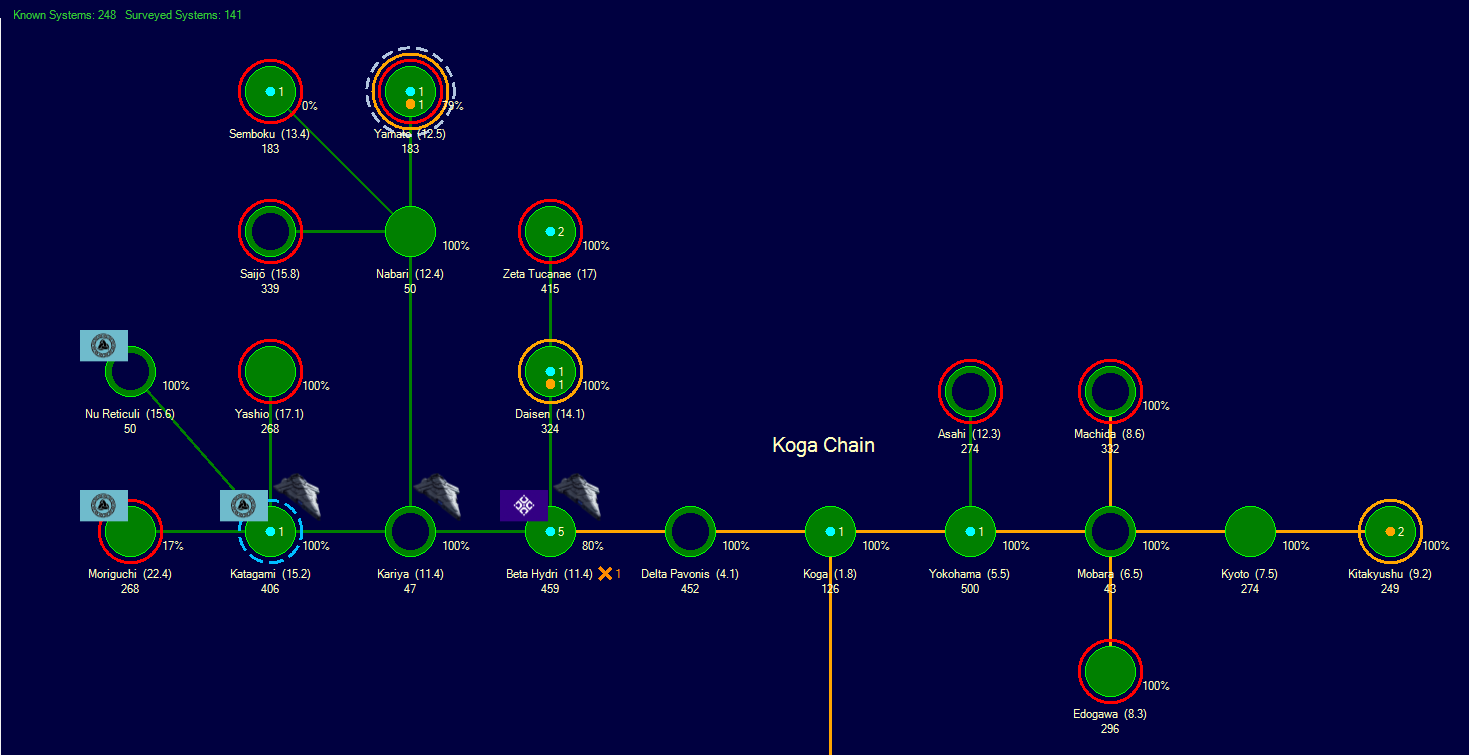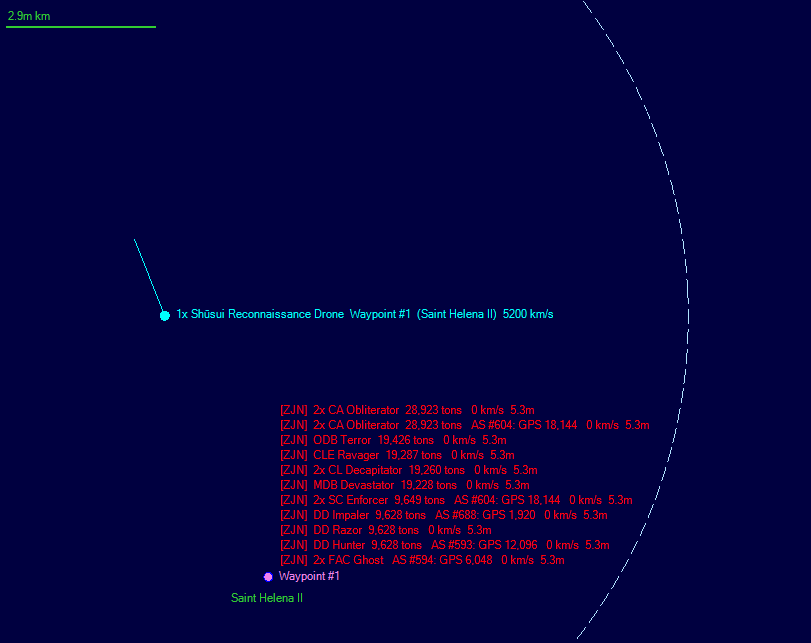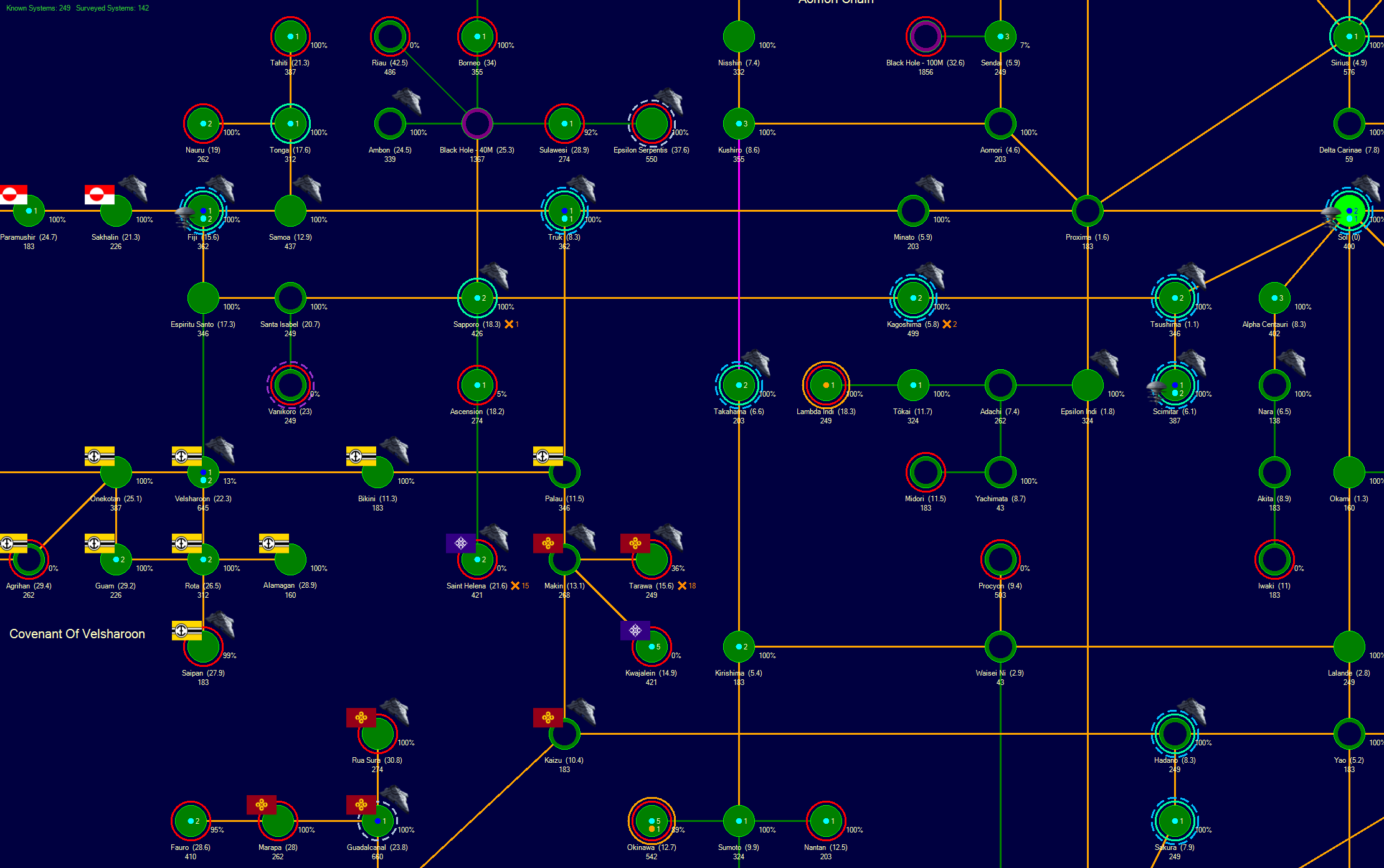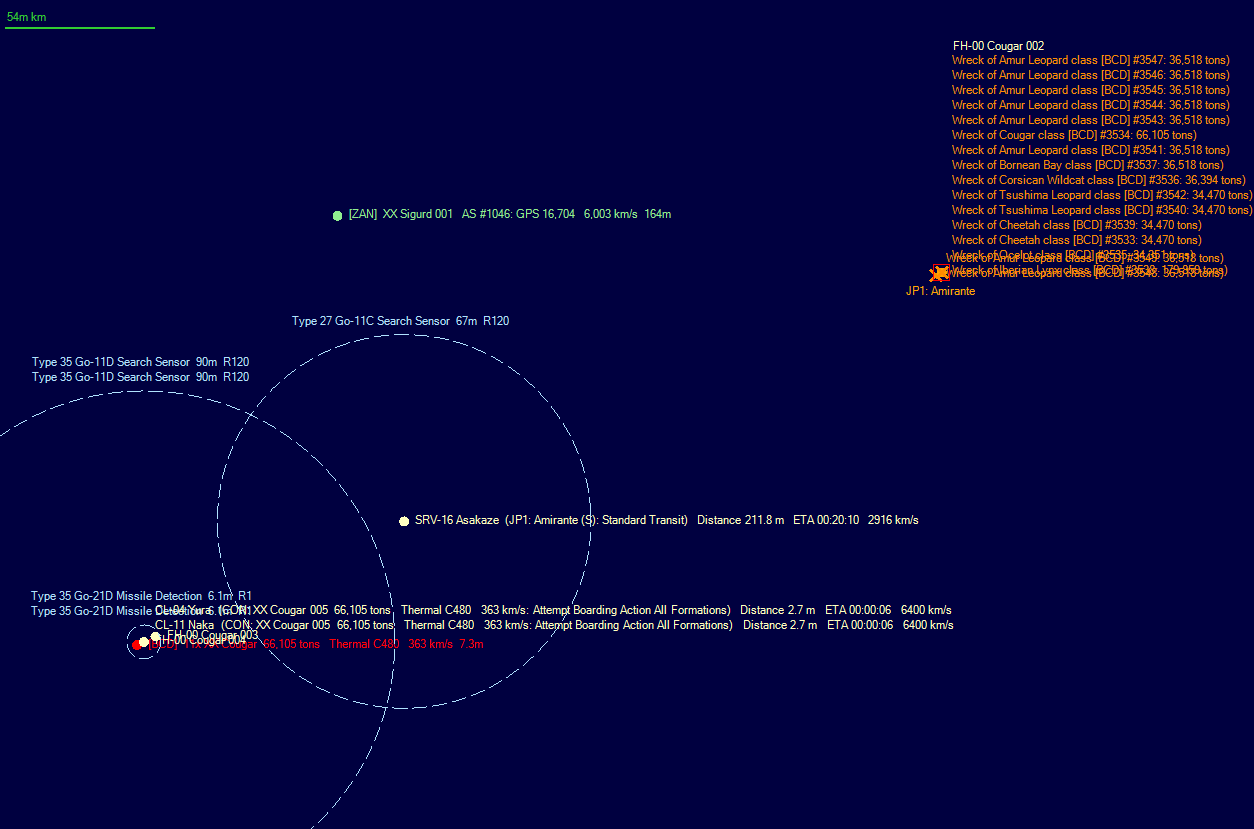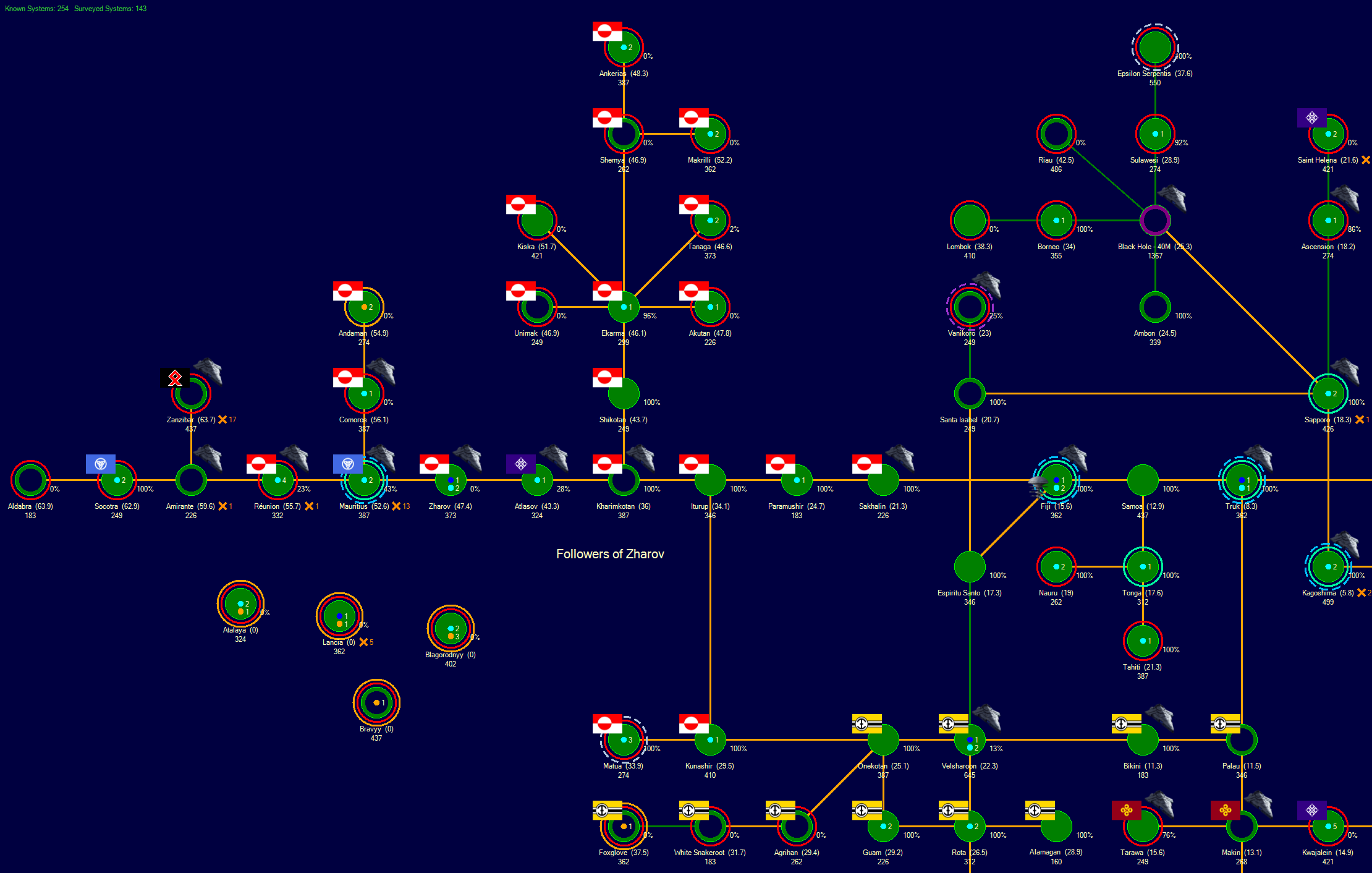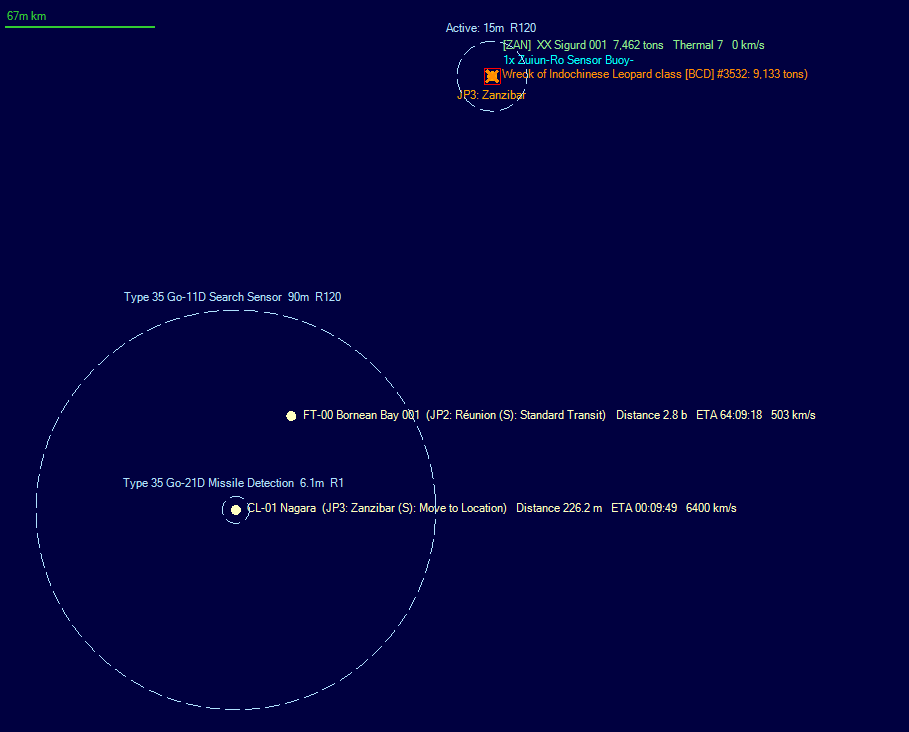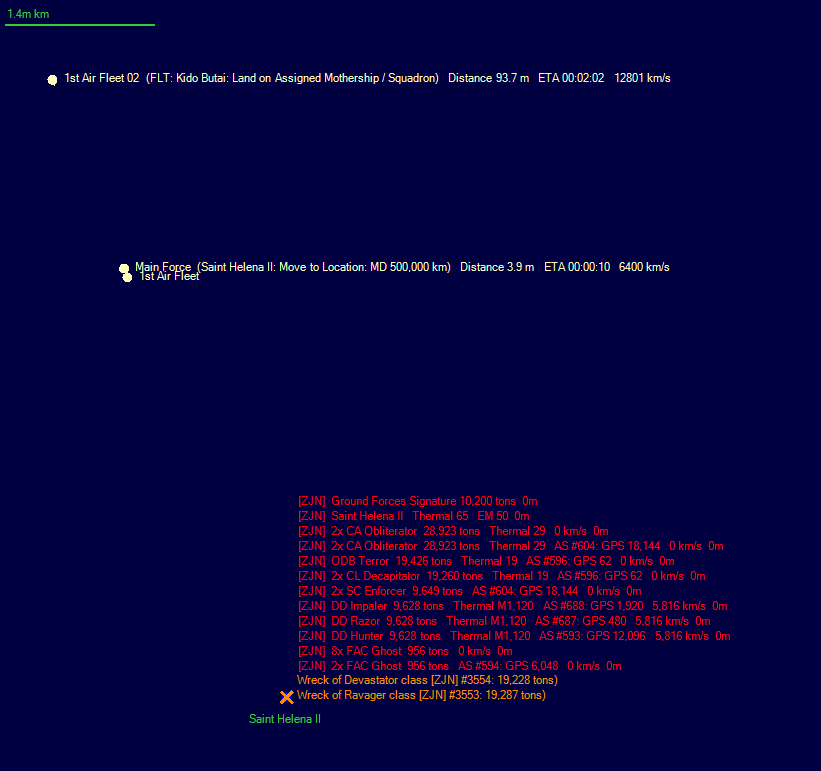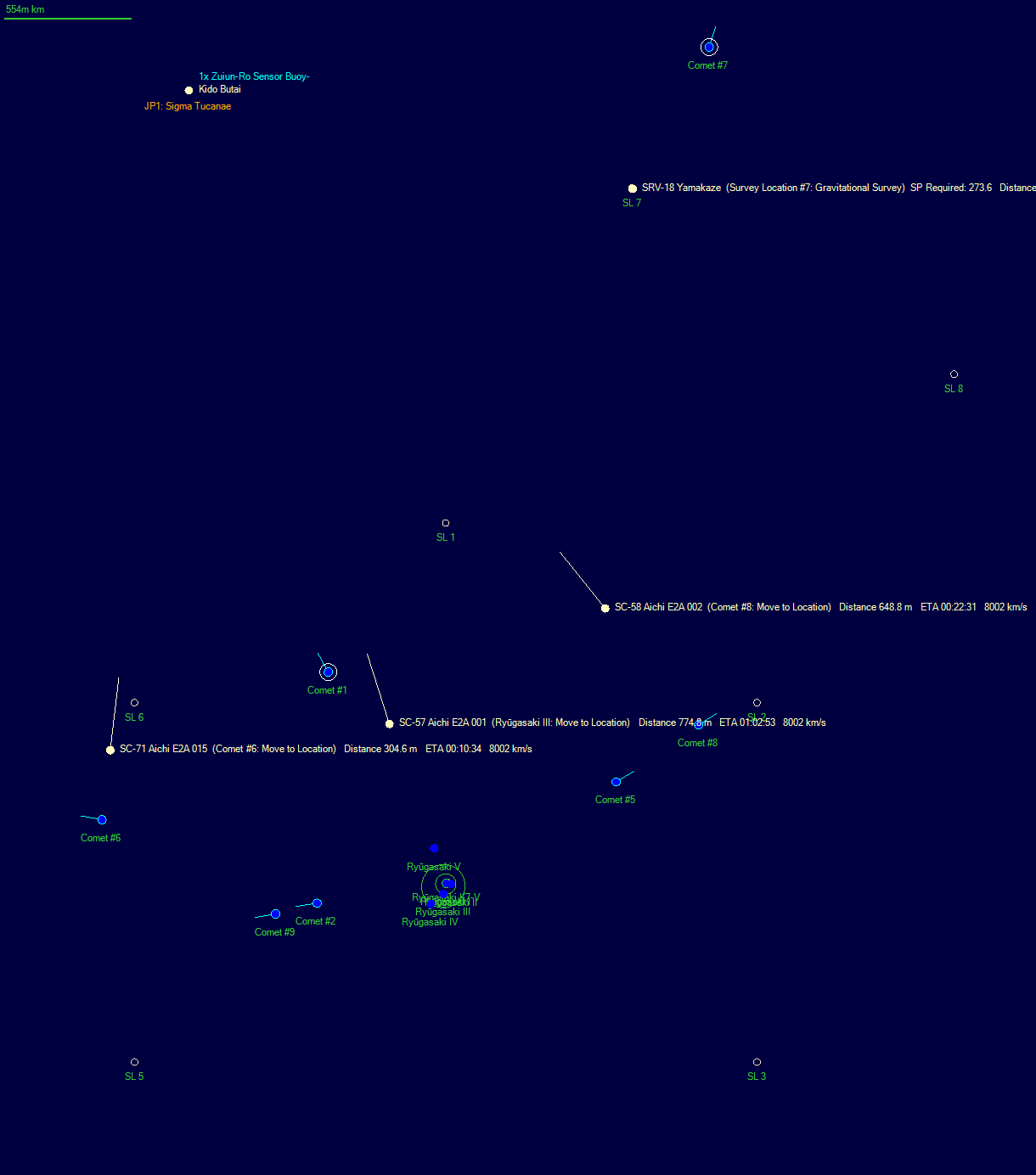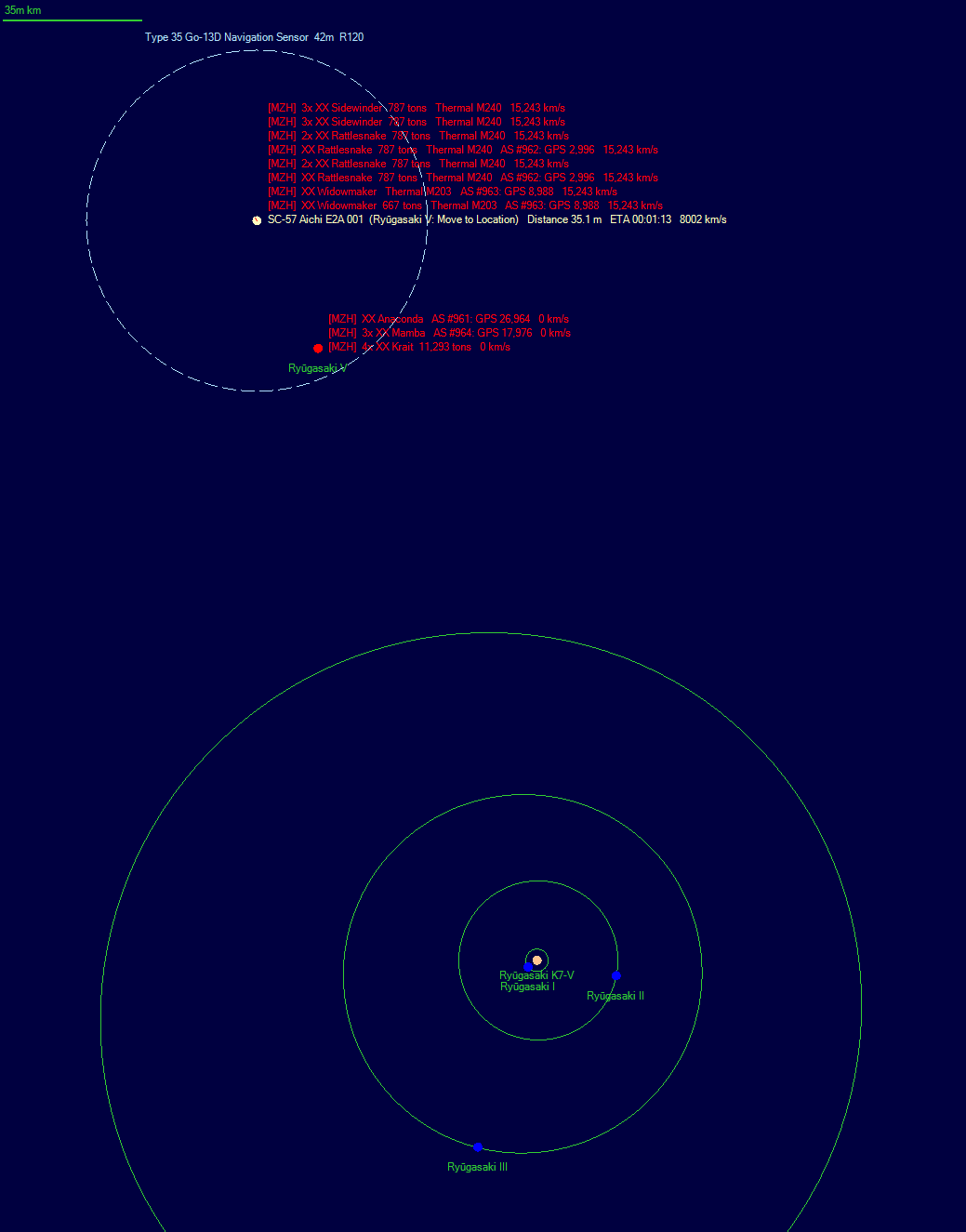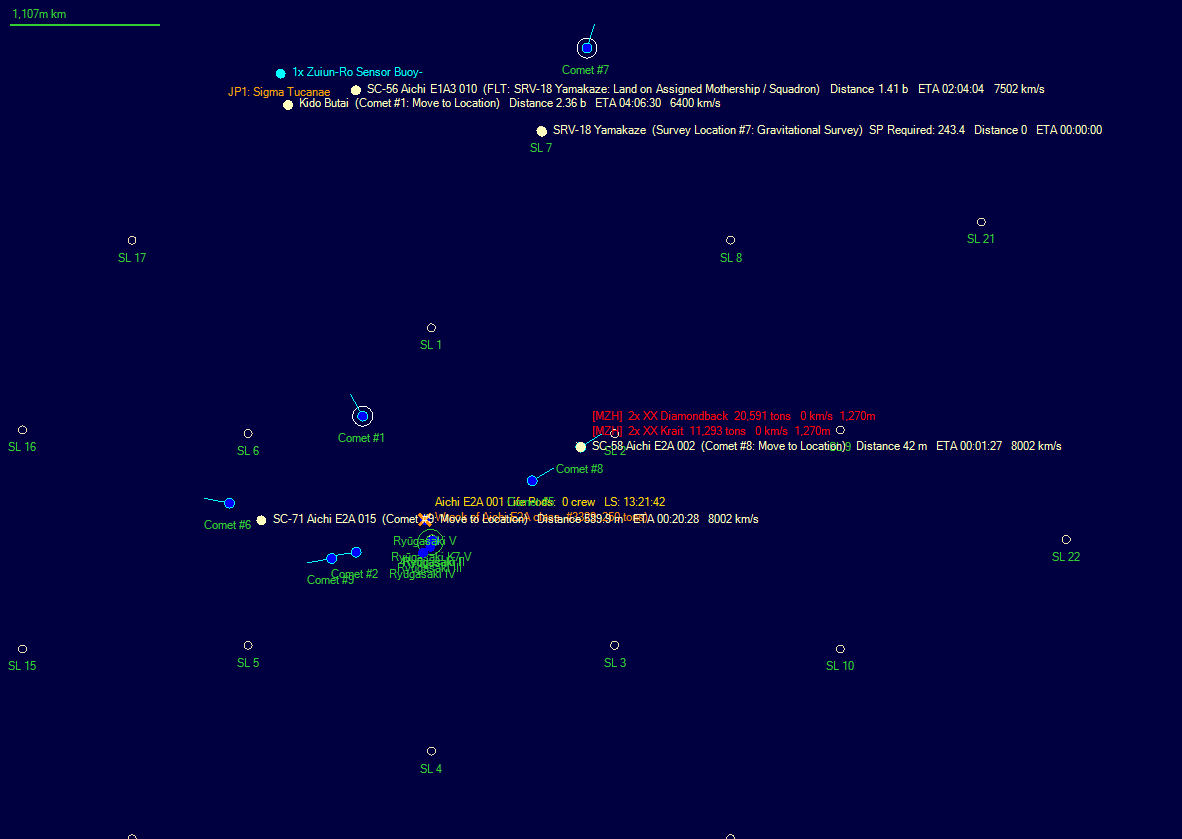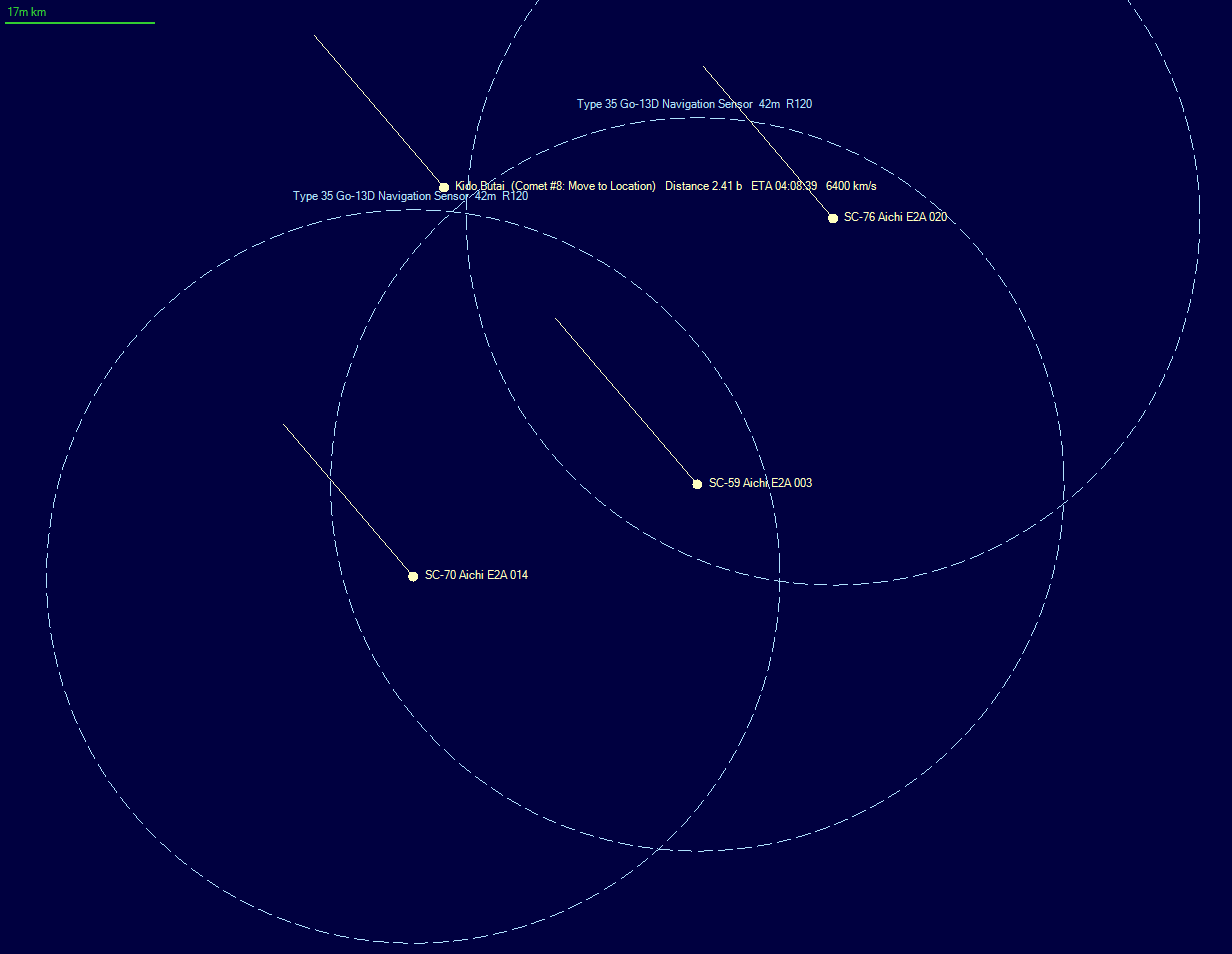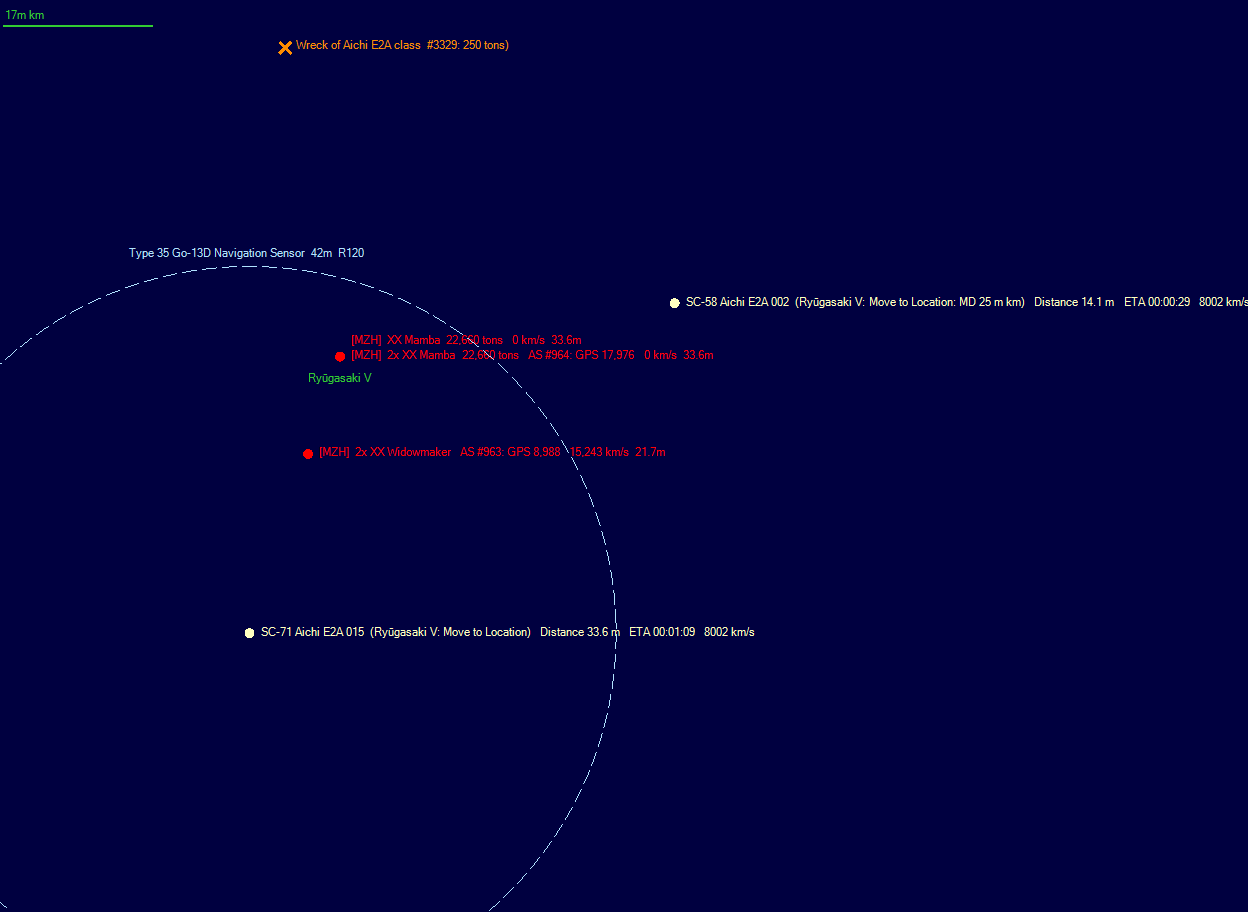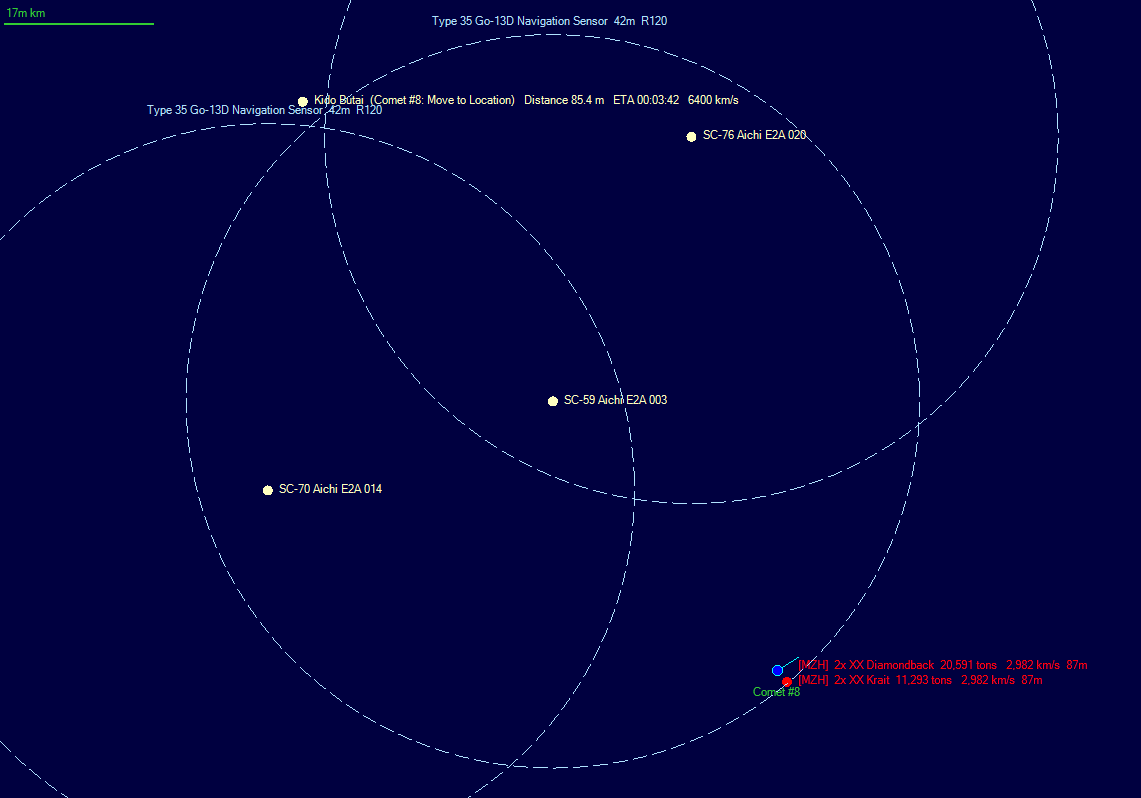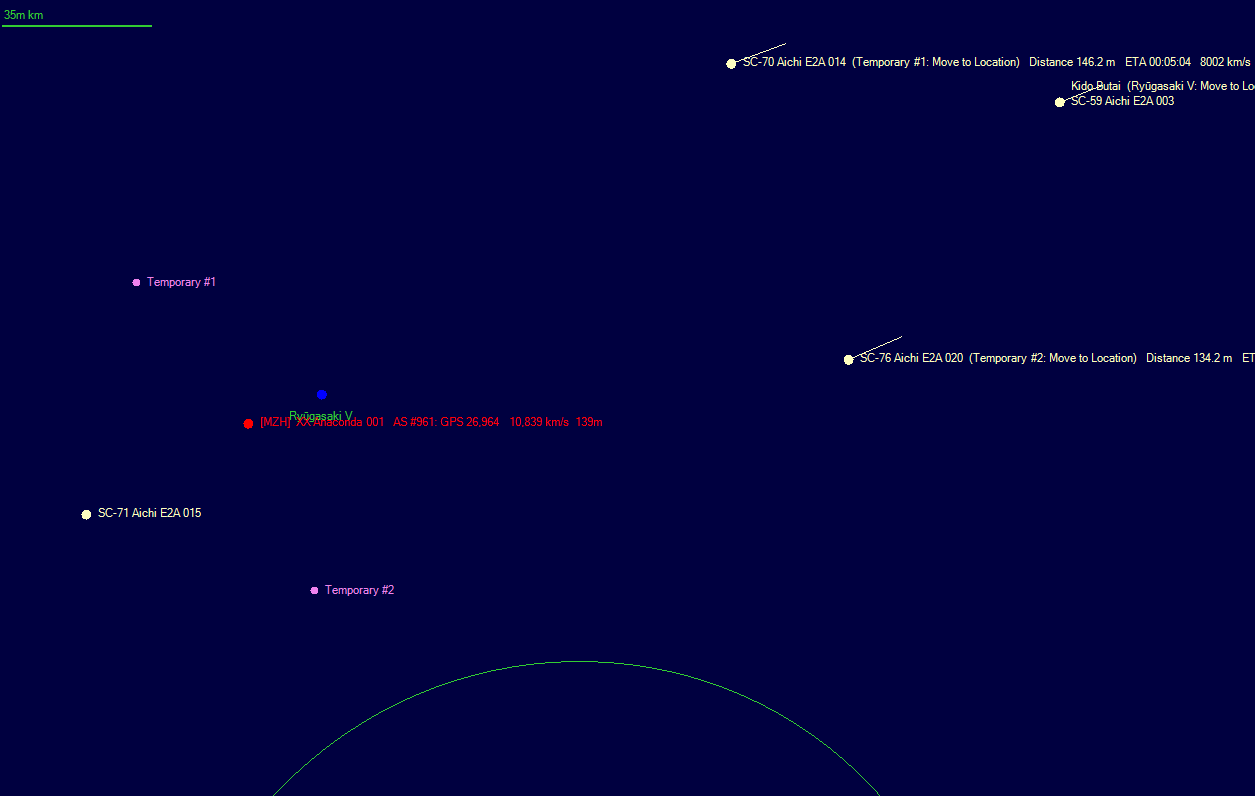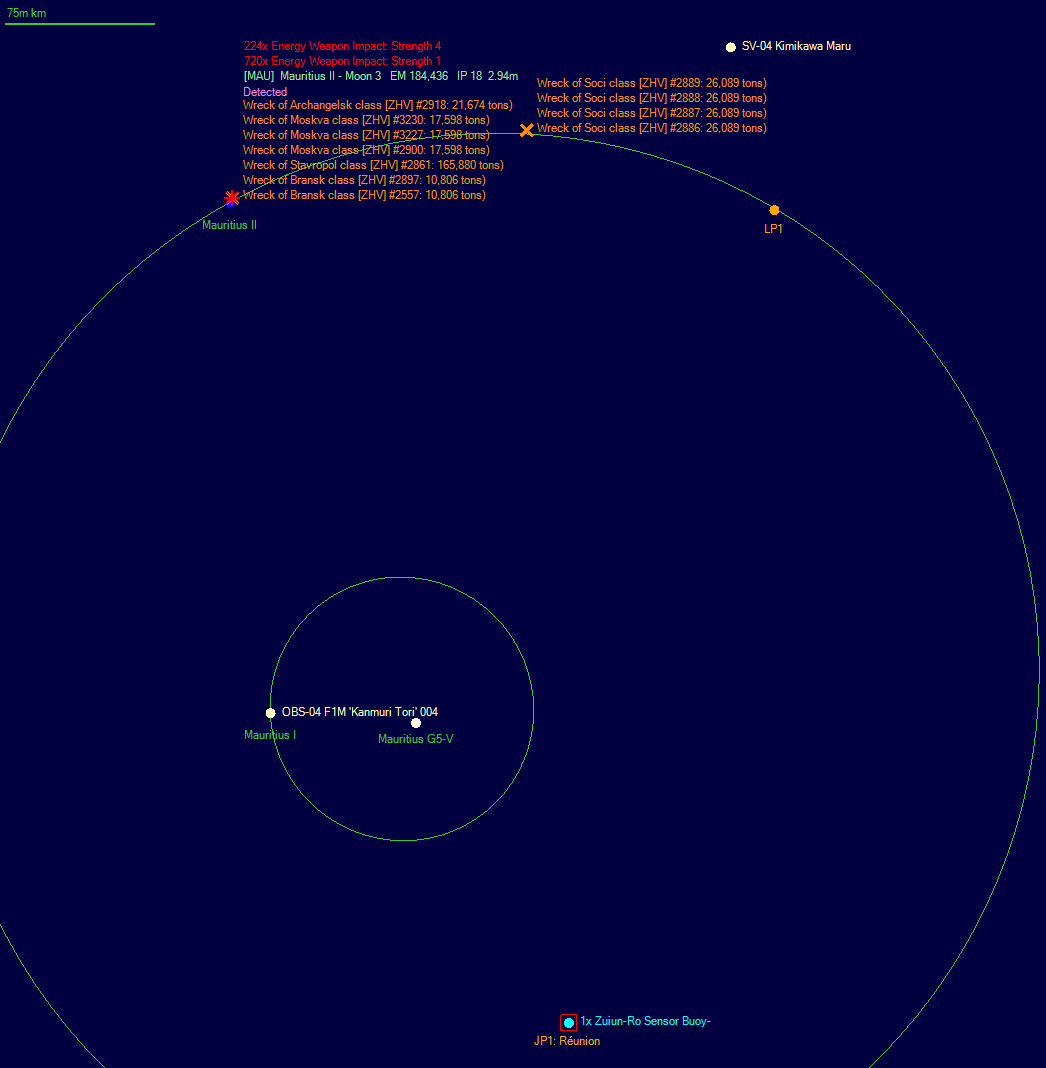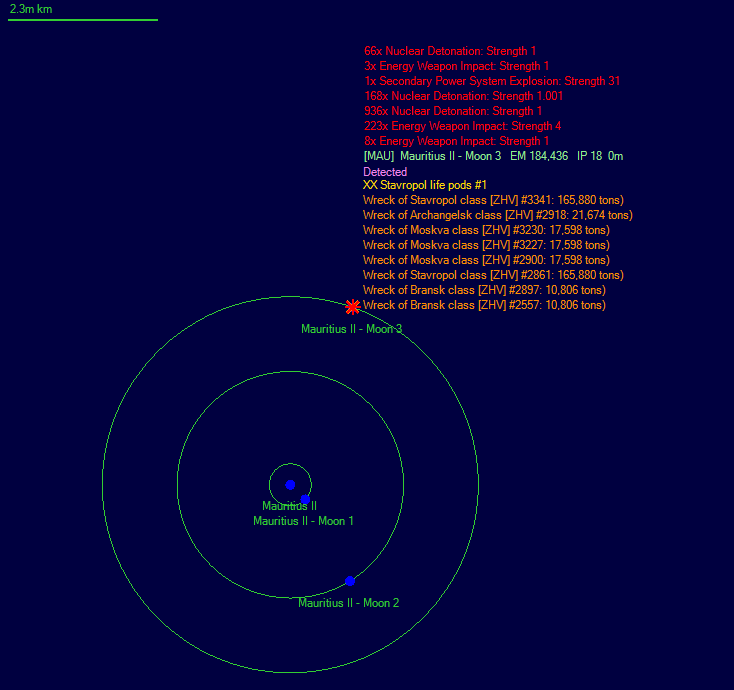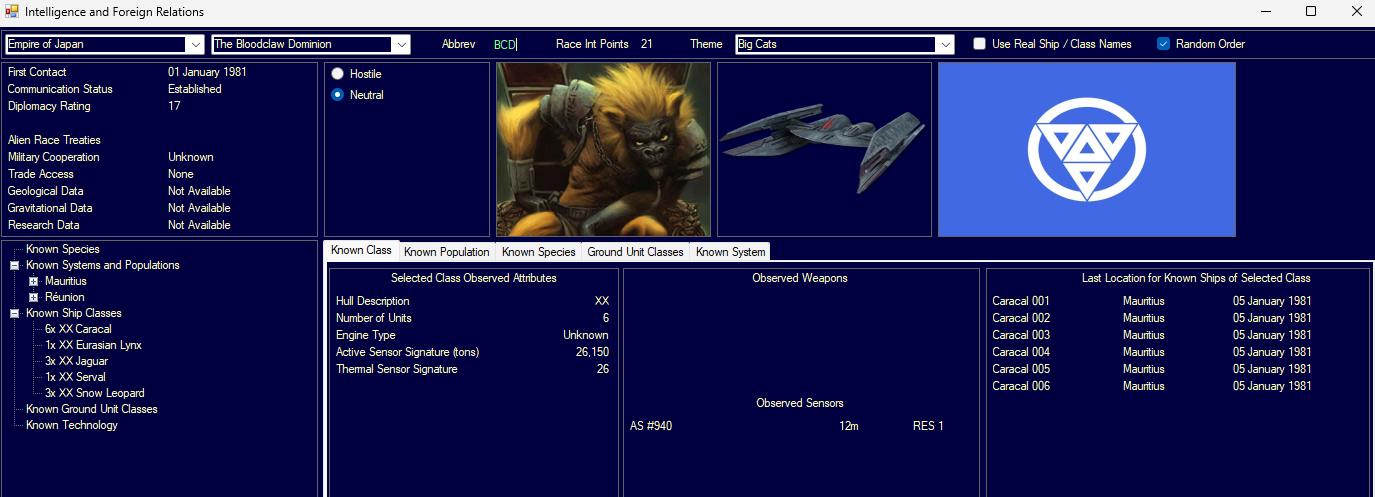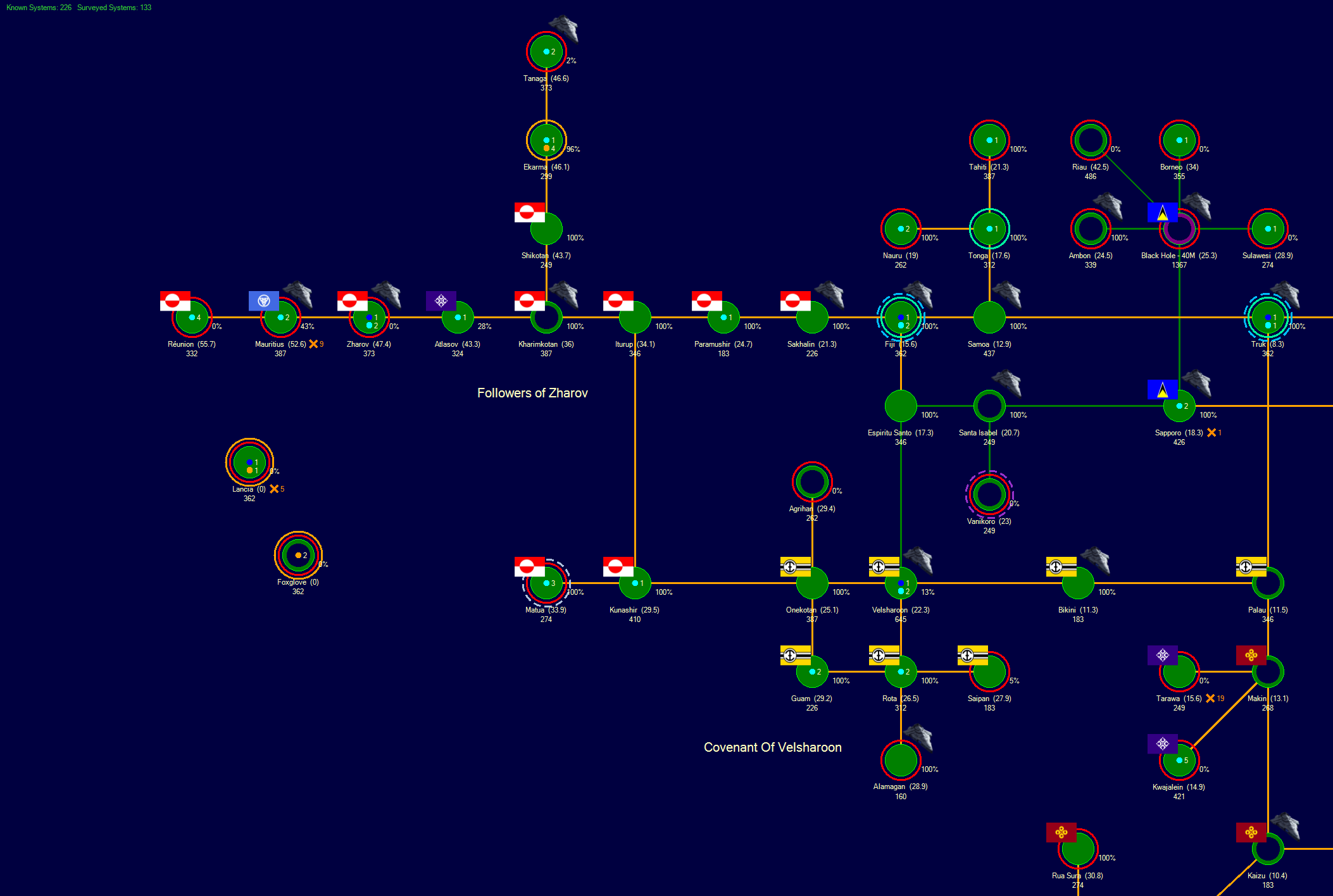1
Humanity First / Humanity First: Final Assault on Chi Draconis
« Last post by Kurt on Today at 11:28:19 AM »January 14, 2145: The Retribution Fleet sets out for Shield Base. It has been reinforced to include 1xStar(C) BB, 2xStar Flight Ib BB, 3xCV, 3xPlanet Flt IIIc BC’s, 3xCVS, 1xAnnihilator Flt IVb Jump Cruiser, 1xHero Flt IVb DD, 7xHero Flt IVb DD, 8xShield Flt III DDE, 78xEagle Class Strike Fighters, 36xForward Flt II class attack fighters, 9xAegis Scout Fighters. The Empire intends for this to be the last sortie against the Swarm in Chi Draconis. To reinforce the fleet to this size, the Solar system has been stripped of most of the fleet’s capital ships. In fact, only the battlecruiser Jupiter has been left behind to defend the solar system, although it is well supported by interceptors, destroyers, and destroyer escorts.
January 31, 2145: The Retribution Fleet arrives at Shield Base and begins refueling. It is reinforced by a jump cruiser from the Base’s fleet, two scouts, and a tug. In addition, a group of tankers are dispatched to the Gamma Carinae system to support the fleet. The tankers and tug will have to assemble in the Luhman system as that’s where the jump gate network ends, and there are no jump ships of the correct type to escort them further until the jump troopship assigned to Monoceri can return from transporting survey teams to the frontier.
February 8, 2145: The Retribution Fleet has arrived at the jump point to Chi Draconis and joined the two scouts that had arrived several days earlier. The fleet jumps through, and after confirming the far side is clear, sends a ship back to bring the scouts in. After detaching a jump cruiser to watch the jump point, the fleet and the two scouts move in-system to the waypoint established in previous attacks as the assembly point for the carriers to launch their strikes.
February 12, 2145: The fleet is now in position, 650 mkm’s from the only planet in the system, the known assembly point for the swarm fleet. Admiral McCullick orders the fleet to close to point #2, approximately 250 mkm’s closer, so that the scout’s very sensitive sensors can determine if the swarm fleet is still present.
February 13,2 145: The scouts are now within theoretical range of their active sensors, but detect nothing over the planet. Unlike the raiders, the swarm is not known to use active emission reduction tech, so if they were present the scouts should be able to see them. Admiral McCullick orders the fleet and the scouts to continue closing.
By 0927 hours the fleet has closed to 250 mkm’s from the planet and continues to detect nothing. At this point Admiral McCullick orders the carriers to launch their missile-armed fighters, along with their Aegis scout fighters, to probe closer to the planet.
At 1215 hours, at 41 mkm’s from the planet, the fighters detect fourteen small swarm ships at the planet, of four classes all sub-1,000 tons. The fighters continue to close after reporting the contact to the fleet.
Unlike during the previous attacks, the small craft maintained their orbit and didn’t react to the approach of the fighters. Eleven fighters fired their missiles, each targeting a different swarm ship with their eight missiles, but three failed to get a lock on as the three abductors were too small to target and they would have to close even more to get a lock on. The swarm ships started running when the fighters launched, but it was too late. The missile wave swooped in on the fleeing swarm ships and wiped all eleven from space, leaving three Abductors to continue running.
The fighters continued to close, and when they reached one million kilometers they opened fire again, sending twenty-four missiles against the remaining three small craft, wiping them from space.
With the known swarm ships destroyed, the fighters set out along their last course. The swarm ships had originally begun running directly away from the fighters when they had launched their missiles, but after the first missile wave destroyed the bulk of their fleet, the remaining three small craft had turned approximately 90 degrees out-system and continued running. Lt Commander Wireman was curious if they were running towards something.
After continuing along this course for three hours and detecting nothing, Commander Wireman ordered his fighters to turn back and head towards the planet. The fleet began moving towards the planet as well.
February 14, 2145: The fleet has now assembled one million kilometers from the planet. No ground units have been detected, so Admiral McCullick orders the fleet to orbit the planet. The missing heavy ships is a concern, especially as there is no place else to go in the system. There are survey ships en route to the system to complete a survey, and the fleet will wait for them in the hopes of tracking down the swarm to where ever it is hiding.
April 3, 2145: A gravitic survey group arrives in the Chi Draconis system and immediately splits up to begin surveying for new jump points.
April 5, 2145: The geo-survey group dispatched to assist the Retribution Fleet has arrived and probed the unknown jump point in the Gamma Carinae system, adjacent to the Chi Draconis system. They have discovered a system with a red star primary, a Venusian planet, four gas giants with eighty-four moons, and a dwarf outer planet. They jump back to Gamma Carinae and set out for the Chi Draconis system to survey the swarm planet.
April 25, 2145: The survey ship completes its survey of Chi Draconis B-I, finding large deposits of eight different TN resources, some of which are present at good availability levels. This, perhaps, explains the presence of the swarm, however, there is no sign of a mining effort. The planet is terrestrial, but with a Venusian type atmosphere at 55 atmospheres of pressure and an average ground temp of 1188 degrees centigrade. The gravitic survey continues.
June 13, 2145: The survey of the Chi Draconis system is nearly complete. No new swarm ships have been discovered, but one new jump point has been localized. Admiral McCullick dispatches the jump cruiser Eradicator, escorted by a destroyer, a destroyer escort, and a scout to probe the jump point.
June 24, 2145: The jump cruiser and her escorts jump into the new system and are immediately taken under fire by two swarm ships in close proximity to the jump point. The Eradicator’s sensors show a 21,030-ton Abomination and a 10,699-ton Abuser sitting just 20,000 kilometers from the jump point. Fortunately, the Terran squadron jumped into the system about 95,000 kilometers from the swarm ships, giving them a little time to get organized. The Abomination targeted the Eradicator with eighteen energy weapons of some sort, causing minor shield damage from the one that managed to hit.
Captain Boddy, aboard the Eradicator, ordered his squadron to target the Abomination. While the Terran ships tried to get their weapons into action, the swarm ships headed for the jump point. Ten seconds after the Terran ships appeared in the system, the swarm ships jumped out, appearing close to the Terran scout left behind in the Chi Draconis system.
The scout, surprised, did the only thing it could and jumped through to the new system, as Captain Boddy ordered his squadron to pursue the swarm ships. The scout jumped through to the new system as the Eradicator and her escorts approached the jump point. Fifteen seconds after the swarm ships jumped to Chi Draconis, the squadron jumped after them.
They appeared in the Chi Draconis system to see the two swarm ships 60,000 kilometers away and fleeing at 2,732 km/s, which appeared to be the Abomination’s top speed. Captain Roddy ordered his squadron to pursue while they readied their weapons. The Eradicator suffered to hits to her shields when she appeared. As they raced away from the jump point, Captain Roddy changed the squadron’s targeting to the Abuser, which had a top speed higher than his ships, and could potentially escape if they destroyed the larger Abomination first.
As they raced away from the jump point the Abuser opened fire with its lasers, seriously depleting the Eradicator’s shields. Five seconds later the Abuser fired its lasers again, reducing the Eradicator’s shields to 21%. The next salvo from the Abuser dropped the Eradicator’s shields and scored her armor, but at that point the Eradicator opened fire, getting hits with its 31.25cm spinal laser, two of its 15cm lasers, and four of its turret-mounted 10cm lasers. All of the hits on the Abuser appeared to have been absorbed by its armor.
The Eradicator took another seven hits to its armor, but now the DDE Ancile and the DD Victor Aita opened fire, launching a salvo of AMM’s at the fleeing Abuser and scoring its armor with 15 cm lasers. At this point the Abuser accelerated away from the Abomination, opening the range on the Terran squadron.
As the Abuser raced away, the Terrans got multiple hits with their lasers, getting a penetration, but there was no apparent damage. The Abuser shifted its fire to the Terran DD, getting several hits on its armor. At this point, Captain Roddy ordered the squadron to accelerate and pursue the fleeing Abuser, but to shift most targeting to the Abomination, which they would pass close to during their pursuit of the Abuser. Only the Eradicator’s spinal laser and the DDE’s missiles would continue to target the Abuser, for now.
The next salvo from the Terran ships pounded the Abomination at 26,000 kilometers, getting sixteen laser hits and sixteen gauss cannon hits, with one penetration. In response, the Abuser continued to target the DD Aita, getting three hits. The next salvo pounded the Abomination from just 8,435 kilometers range. Once again, the Terrans got multiple hits and one penetration, but as with the first salvo, the penetration came from a gauss cannon round, and so was low power. The Abuser continued to fire on the Terran DD, getting multiple hits on its armor.
The Terran squadron was now past the Abomination, which turned back towards the jump point. The next Terran salvo on the retreating Abomination was at nearly 50,000 kilometers. They got multiple hits, and one of the Eradicator’s turrets punched right through a previous penetration and took out one of the Abomination’s engines, reducing it to half speed. The Eradicator’s spinal laser, finally recharged, stabbed out at the Abuser, now at 71,000 kilometers, but missed. Captain Roddy ordered one more salvo at the Abomination, and then for all ships to shift targeting to the Abuser. The next salvo ripped the Abomination from end to end, leaving her drifting. The Terran ships shifted targeting to the Abuser. The Abuser had continued targeting the Aita, whose armor was down to 88%.
The battle stretched out as the Abuser continued running ahead of the Terran ships. The range had stabilized at around 80,000 kilometers. Ten seconds later, the human ships got a penetrating hit that took out an engine, dropping the Abuser’s speed to 8,057 km/s, just slightly faster than the human ships. The next salvo of laser fire caused a massive internal explosion that destroyed the Abuser. The Terran ships turned back towards the Abomination, and after four salvoes the Abomination blew up. The Terran squadron sent off a contact report to the Retribution Fleet and then jumped through to join the scout in the newly discovered HIP 31292 system. The system consisted of a lonely M3-V star orbited by two small comets.
With the system clear, the gravitic survey group is dispatched from Chi Draconis to the new system to begin their survey and to determine if more swarm ships are present. Admiral McCullick decided to relocate his fleet to the jump point to HIP 31292 to be closer to the surveying forces.
August 24, 2145: The Empire’s first Dreadnought, the Andromeda, is launched and begins its training flight. The 80,000 ton warship is the pinnacle of Imperial Naval might, and when it is done training it will assume the position of fleet flagship.
Meanwhile, the survey of the HIP 31292 system is complete, and an astounding five new jump points have been discovered, bringing the system’s total to six. Only one other system in the empire has close to this number, the Luhman 16 system, with five jump points. This is frustrating for Admiral McCullick, who was hoping to track down the missing swarm ships. Mindful of the fact that the swarm were picketing the jump point to the HIP 31292 system, Admiral McCullick reorganizes his fleet, detaching two jump-capable groups. Group one consists of the flagship, reinforced by the three ships of the Mercury battlegroup. The second group was built around the jump cruiser Eradicator, reinforced by the Saturn battlegroup. The Eradicator’s former escorts were returned to the fleet. The two groups set out to probe the newly discovered jump points.
September 18, 2145: The Antares jumps through the third new jump point in the HIP 31292 system, discovering a red star system with a planet with an oxygen-nitrogen atmosphere. The planet is cold, with a thin atmosphere, but given the Reaper’s penchant for occupying such planets, Admiral McCullick calls forward the Retribution fleet to perform a probe in force of the system.
September 20, 2145: The Retribution Fleet is stationed at the jump point, and the Antares, escorted by the Mercury battle group and two carriers, heads in-system.
September 24, 2145: Having found nothing at the planet, the Antares and her escorts turn back towards the jump point.
September 30, 2145: The jump cruiser Eradicator jumps through the last unexplored jump point in the HIP 31292 system and materializes in the Omicron Tucanae system, a previously discovered system on the frontier. The system contains a Terra-like planet with an atmosphere just a bit too thin, and an environment a bit too cold for human habitation. The planet was previously probed, but considering they are searching for missing swarm ships, Captain Boddy decides to head in-system and probe the planet again, after reporting his discovery to the Retribution Fleet.
October 3, 2145: The planet is still clear, so the Eradicator and her escorts turn back towards the jump point to HIP 31292 to rejoin the fleet.
October 13, 2145: The Retribution Fleet has reassembled in the HIP 31292 system. Admiral McCullick decides to return to Shield Base to refuel and resupply. He leaves behind the two survey groups and the scouts to watch for the return of the Swarm.
November 2, 2145: The Retribution Fleet arrives over Shield Base to refuel and resupply. Admiral McCullick, pursuant to orders from Terra, detaches a battleship, two battlecruiser groups, a jump cruiser, and a carrier and two strike carriers to reinforce Shield Base, then sets out for home.
November 11, 2145: A troop transport group sets out from Terra, carrying the 12th Guard Division(reinforced), and a large contingent of STO batteries to establish a forward base on the lone planet in the Chi Draconis System. The new base will be named Bastion Base, once fully established.
November 22, 2145: The Retribution Fleet has arrived over Terra and the government announces its success in destroying or scattering the swarm.
The Emperor gives a system-wide speech extolling the victory of the fleet and the elimination of another threat to humanity’s expansion to the stars, after which he gives out awards and commendations to officers and crews of the Retribution Fleet. A week of celebration is announced to welcome the fleet home. The speech is well received, and the elimination of another threat is welcomed by nearly all. The fact that the swarm flagship and several other ships are missing is not mentioned, and is kept a closely held secret. And while still a minority, there is a growing peace movement that opposes the militarization that characterizes the Empire and its approach to other species, and its leaders are questioning the necessity of genocide against aliens that were never given a chance to talk or surrender.
January 31, 2145: The Retribution Fleet arrives at Shield Base and begins refueling. It is reinforced by a jump cruiser from the Base’s fleet, two scouts, and a tug. In addition, a group of tankers are dispatched to the Gamma Carinae system to support the fleet. The tankers and tug will have to assemble in the Luhman system as that’s where the jump gate network ends, and there are no jump ships of the correct type to escort them further until the jump troopship assigned to Monoceri can return from transporting survey teams to the frontier.
February 8, 2145: The Retribution Fleet has arrived at the jump point to Chi Draconis and joined the two scouts that had arrived several days earlier. The fleet jumps through, and after confirming the far side is clear, sends a ship back to bring the scouts in. After detaching a jump cruiser to watch the jump point, the fleet and the two scouts move in-system to the waypoint established in previous attacks as the assembly point for the carriers to launch their strikes.
February 12, 2145: The fleet is now in position, 650 mkm’s from the only planet in the system, the known assembly point for the swarm fleet. Admiral McCullick orders the fleet to close to point #2, approximately 250 mkm’s closer, so that the scout’s very sensitive sensors can determine if the swarm fleet is still present.
February 13,2 145: The scouts are now within theoretical range of their active sensors, but detect nothing over the planet. Unlike the raiders, the swarm is not known to use active emission reduction tech, so if they were present the scouts should be able to see them. Admiral McCullick orders the fleet and the scouts to continue closing.
By 0927 hours the fleet has closed to 250 mkm’s from the planet and continues to detect nothing. At this point Admiral McCullick orders the carriers to launch their missile-armed fighters, along with their Aegis scout fighters, to probe closer to the planet.
At 1215 hours, at 41 mkm’s from the planet, the fighters detect fourteen small swarm ships at the planet, of four classes all sub-1,000 tons. The fighters continue to close after reporting the contact to the fleet.
Unlike during the previous attacks, the small craft maintained their orbit and didn’t react to the approach of the fighters. Eleven fighters fired their missiles, each targeting a different swarm ship with their eight missiles, but three failed to get a lock on as the three abductors were too small to target and they would have to close even more to get a lock on. The swarm ships started running when the fighters launched, but it was too late. The missile wave swooped in on the fleeing swarm ships and wiped all eleven from space, leaving three Abductors to continue running.
The fighters continued to close, and when they reached one million kilometers they opened fire again, sending twenty-four missiles against the remaining three small craft, wiping them from space.
With the known swarm ships destroyed, the fighters set out along their last course. The swarm ships had originally begun running directly away from the fighters when they had launched their missiles, but after the first missile wave destroyed the bulk of their fleet, the remaining three small craft had turned approximately 90 degrees out-system and continued running. Lt Commander Wireman was curious if they were running towards something.
After continuing along this course for three hours and detecting nothing, Commander Wireman ordered his fighters to turn back and head towards the planet. The fleet began moving towards the planet as well.
February 14, 2145: The fleet has now assembled one million kilometers from the planet. No ground units have been detected, so Admiral McCullick orders the fleet to orbit the planet. The missing heavy ships is a concern, especially as there is no place else to go in the system. There are survey ships en route to the system to complete a survey, and the fleet will wait for them in the hopes of tracking down the swarm to where ever it is hiding.
April 3, 2145: A gravitic survey group arrives in the Chi Draconis system and immediately splits up to begin surveying for new jump points.
April 5, 2145: The geo-survey group dispatched to assist the Retribution Fleet has arrived and probed the unknown jump point in the Gamma Carinae system, adjacent to the Chi Draconis system. They have discovered a system with a red star primary, a Venusian planet, four gas giants with eighty-four moons, and a dwarf outer planet. They jump back to Gamma Carinae and set out for the Chi Draconis system to survey the swarm planet.
April 25, 2145: The survey ship completes its survey of Chi Draconis B-I, finding large deposits of eight different TN resources, some of which are present at good availability levels. This, perhaps, explains the presence of the swarm, however, there is no sign of a mining effort. The planet is terrestrial, but with a Venusian type atmosphere at 55 atmospheres of pressure and an average ground temp of 1188 degrees centigrade. The gravitic survey continues.
June 13, 2145: The survey of the Chi Draconis system is nearly complete. No new swarm ships have been discovered, but one new jump point has been localized. Admiral McCullick dispatches the jump cruiser Eradicator, escorted by a destroyer, a destroyer escort, and a scout to probe the jump point.
June 24, 2145: The jump cruiser and her escorts jump into the new system and are immediately taken under fire by two swarm ships in close proximity to the jump point. The Eradicator’s sensors show a 21,030-ton Abomination and a 10,699-ton Abuser sitting just 20,000 kilometers from the jump point. Fortunately, the Terran squadron jumped into the system about 95,000 kilometers from the swarm ships, giving them a little time to get organized. The Abomination targeted the Eradicator with eighteen energy weapons of some sort, causing minor shield damage from the one that managed to hit.
Captain Boddy, aboard the Eradicator, ordered his squadron to target the Abomination. While the Terran ships tried to get their weapons into action, the swarm ships headed for the jump point. Ten seconds after the Terran ships appeared in the system, the swarm ships jumped out, appearing close to the Terran scout left behind in the Chi Draconis system.
The scout, surprised, did the only thing it could and jumped through to the new system, as Captain Boddy ordered his squadron to pursue the swarm ships. The scout jumped through to the new system as the Eradicator and her escorts approached the jump point. Fifteen seconds after the swarm ships jumped to Chi Draconis, the squadron jumped after them.
They appeared in the Chi Draconis system to see the two swarm ships 60,000 kilometers away and fleeing at 2,732 km/s, which appeared to be the Abomination’s top speed. Captain Roddy ordered his squadron to pursue while they readied their weapons. The Eradicator suffered to hits to her shields when she appeared. As they raced away from the jump point, Captain Roddy changed the squadron’s targeting to the Abuser, which had a top speed higher than his ships, and could potentially escape if they destroyed the larger Abomination first.
As they raced away from the jump point the Abuser opened fire with its lasers, seriously depleting the Eradicator’s shields. Five seconds later the Abuser fired its lasers again, reducing the Eradicator’s shields to 21%. The next salvo from the Abuser dropped the Eradicator’s shields and scored her armor, but at that point the Eradicator opened fire, getting hits with its 31.25cm spinal laser, two of its 15cm lasers, and four of its turret-mounted 10cm lasers. All of the hits on the Abuser appeared to have been absorbed by its armor.
The Eradicator took another seven hits to its armor, but now the DDE Ancile and the DD Victor Aita opened fire, launching a salvo of AMM’s at the fleeing Abuser and scoring its armor with 15 cm lasers. At this point the Abuser accelerated away from the Abomination, opening the range on the Terran squadron.
As the Abuser raced away, the Terrans got multiple hits with their lasers, getting a penetration, but there was no apparent damage. The Abuser shifted its fire to the Terran DD, getting several hits on its armor. At this point, Captain Roddy ordered the squadron to accelerate and pursue the fleeing Abuser, but to shift most targeting to the Abomination, which they would pass close to during their pursuit of the Abuser. Only the Eradicator’s spinal laser and the DDE’s missiles would continue to target the Abuser, for now.
The next salvo from the Terran ships pounded the Abomination at 26,000 kilometers, getting sixteen laser hits and sixteen gauss cannon hits, with one penetration. In response, the Abuser continued to target the DD Aita, getting three hits. The next salvo pounded the Abomination from just 8,435 kilometers range. Once again, the Terrans got multiple hits and one penetration, but as with the first salvo, the penetration came from a gauss cannon round, and so was low power. The Abuser continued to fire on the Terran DD, getting multiple hits on its armor.
The Terran squadron was now past the Abomination, which turned back towards the jump point. The next Terran salvo on the retreating Abomination was at nearly 50,000 kilometers. They got multiple hits, and one of the Eradicator’s turrets punched right through a previous penetration and took out one of the Abomination’s engines, reducing it to half speed. The Eradicator’s spinal laser, finally recharged, stabbed out at the Abuser, now at 71,000 kilometers, but missed. Captain Roddy ordered one more salvo at the Abomination, and then for all ships to shift targeting to the Abuser. The next salvo ripped the Abomination from end to end, leaving her drifting. The Terran ships shifted targeting to the Abuser. The Abuser had continued targeting the Aita, whose armor was down to 88%.
The battle stretched out as the Abuser continued running ahead of the Terran ships. The range had stabilized at around 80,000 kilometers. Ten seconds later, the human ships got a penetrating hit that took out an engine, dropping the Abuser’s speed to 8,057 km/s, just slightly faster than the human ships. The next salvo of laser fire caused a massive internal explosion that destroyed the Abuser. The Terran ships turned back towards the Abomination, and after four salvoes the Abomination blew up. The Terran squadron sent off a contact report to the Retribution Fleet and then jumped through to join the scout in the newly discovered HIP 31292 system. The system consisted of a lonely M3-V star orbited by two small comets.
With the system clear, the gravitic survey group is dispatched from Chi Draconis to the new system to begin their survey and to determine if more swarm ships are present. Admiral McCullick decided to relocate his fleet to the jump point to HIP 31292 to be closer to the surveying forces.
August 24, 2145: The Empire’s first Dreadnought, the Andromeda, is launched and begins its training flight. The 80,000 ton warship is the pinnacle of Imperial Naval might, and when it is done training it will assume the position of fleet flagship.
Meanwhile, the survey of the HIP 31292 system is complete, and an astounding five new jump points have been discovered, bringing the system’s total to six. Only one other system in the empire has close to this number, the Luhman 16 system, with five jump points. This is frustrating for Admiral McCullick, who was hoping to track down the missing swarm ships. Mindful of the fact that the swarm were picketing the jump point to the HIP 31292 system, Admiral McCullick reorganizes his fleet, detaching two jump-capable groups. Group one consists of the flagship, reinforced by the three ships of the Mercury battlegroup. The second group was built around the jump cruiser Eradicator, reinforced by the Saturn battlegroup. The Eradicator’s former escorts were returned to the fleet. The two groups set out to probe the newly discovered jump points.
September 18, 2145: The Antares jumps through the third new jump point in the HIP 31292 system, discovering a red star system with a planet with an oxygen-nitrogen atmosphere. The planet is cold, with a thin atmosphere, but given the Reaper’s penchant for occupying such planets, Admiral McCullick calls forward the Retribution fleet to perform a probe in force of the system.
September 20, 2145: The Retribution Fleet is stationed at the jump point, and the Antares, escorted by the Mercury battle group and two carriers, heads in-system.
September 24, 2145: Having found nothing at the planet, the Antares and her escorts turn back towards the jump point.
September 30, 2145: The jump cruiser Eradicator jumps through the last unexplored jump point in the HIP 31292 system and materializes in the Omicron Tucanae system, a previously discovered system on the frontier. The system contains a Terra-like planet with an atmosphere just a bit too thin, and an environment a bit too cold for human habitation. The planet was previously probed, but considering they are searching for missing swarm ships, Captain Boddy decides to head in-system and probe the planet again, after reporting his discovery to the Retribution Fleet.
October 3, 2145: The planet is still clear, so the Eradicator and her escorts turn back towards the jump point to HIP 31292 to rejoin the fleet.
October 13, 2145: The Retribution Fleet has reassembled in the HIP 31292 system. Admiral McCullick decides to return to Shield Base to refuel and resupply. He leaves behind the two survey groups and the scouts to watch for the return of the Swarm.
November 2, 2145: The Retribution Fleet arrives over Shield Base to refuel and resupply. Admiral McCullick, pursuant to orders from Terra, detaches a battleship, two battlecruiser groups, a jump cruiser, and a carrier and two strike carriers to reinforce Shield Base, then sets out for home.
November 11, 2145: A troop transport group sets out from Terra, carrying the 12th Guard Division(reinforced), and a large contingent of STO batteries to establish a forward base on the lone planet in the Chi Draconis System. The new base will be named Bastion Base, once fully established.
November 22, 2145: The Retribution Fleet has arrived over Terra and the government announces its success in destroying or scattering the swarm.
The Emperor gives a system-wide speech extolling the victory of the fleet and the elimination of another threat to humanity’s expansion to the stars, after which he gives out awards and commendations to officers and crews of the Retribution Fleet. A week of celebration is announced to welcome the fleet home. The speech is well received, and the elimination of another threat is welcomed by nearly all. The fact that the swarm flagship and several other ships are missing is not mentioned, and is kept a closely held secret. And while still a minority, there is a growing peace movement that opposes the militarization that characterizes the Empire and its approach to other species, and its leaders are questioning the necessity of genocide against aliens that were never given a chance to talk or surrender.


 Recent Posts
Recent Posts
 Project Excalibur is a top secret design project ordered in 2355 by the UNSC, its purpose to design a viable long range strike fighter craft capable of engaging targets up to 150mkm with enough firepower to destroy frigate sized vessels of the day when deployed in squadrons. The fighter was slated for the planned CVX carrier design that would replace the existing Trafalgar class carrier in the 2370s, the result of Excalibur would be the F-62 Gladius Strike-Fighter, the largest ever vessel with such a designation planned for deployment in squadrons of six for both offensive and defensive roles thanks to missile and coilgun armament.
Project Excalibur is a top secret design project ordered in 2355 by the UNSC, its purpose to design a viable long range strike fighter craft capable of engaging targets up to 150mkm with enough firepower to destroy frigate sized vessels of the day when deployed in squadrons. The fighter was slated for the planned CVX carrier design that would replace the existing Trafalgar class carrier in the 2370s, the result of Excalibur would be the F-62 Gladius Strike-Fighter, the largest ever vessel with such a designation planned for deployment in squadrons of six for both offensive and defensive roles thanks to missile and coilgun armament.



